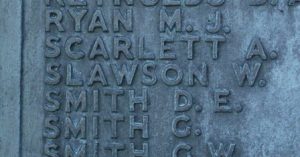Llanidloes is a town and community in Montgomeryshire, situated on the A470 and B4518 roads and is the third largest settlement in Montgomeryshire, after Newtown and Welshpool. It is the first town situated on the River Severn after its source and is a very popular tourist destination, situated in some beautiful countryside. The town takes its name from the early 7th century Celtic Saint Idloes, after whom its parish church is named, and the town is at the geographical centre of Wales. The men of Llanidloes who fell during the Great War are commemorated on the central panel of a large stone monument on the wall of the Town Hall, which also contains the names of the fallen of the neighbouring villages of Llangurig; Trefeglwys; and Llandinam, whilst two additional plaques bear the names of the fallen of World War Two: one plaque containing the names of the Llanidloes fallen, one containing the names of the fallen of the other three villages. These three villages have their own pages on this website, so this page commemorates only the fallen of Llanidloes. I have taken the liberty of adding the details of several men from the town who for one reason or another are not commemorated on the Llanidloes war memorial. Two such men were sons of Llanidloes miners who were killed in the Albion Colliery Disaster in 1894.
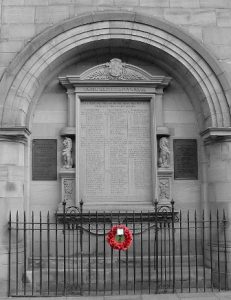
The Great War, 1914-1918
William James Baxter, Sapper, 147795, Royal Engineers. William was born at Trealaw, Rhondda in 1887, the son of Thomas Baxter and Sarah Ann Baxter (nee Jerman). He was raised by his grandmother, Sarah Baxter, in Llanidloes and married Martha Jane Lloyd, of 8, Severn Port, Llanidloes, on 5 April 1915. William worked as a lead miner prior to enlisting into the 14th Battalion, Royal Welsh Fusiliers soon after the outbreak of war. The battalion was raised at Llandudno by the Welsh National Executive Committee, joining 128 Brigade, 43rd (Welsh) Division and trained in North Wales before moving to Winchester in the summer of 1915, where the formation became renumbered 113 Brigade, 38th (Welsh) Division. The Division moved to France on 2 December 1915 and moved to the Nursery Sector near Fleurbaix for trench initiation alongside the Guards Division. The Division then held a sector of the line near Cuinchy before marching south to the Somme sector in June 1916 to take part in the assault on Mametz Wood. The first attack on the wood was launched on a two-battalion front on 7 July, but failed, and the Divisional Commander, Sir Ivor Philipps, was replaced before the Division attacked again on a two Brigade front on 10 July 1916. After two days of ferocious hand-to-hand fighting, the wood was cleared up to its northern edge, before the battered Division was relieved. It then took over a section of the front at Hébuterne before moving to the Ypres Salient, and taking over the Canal Bank sector at Boesinghe. The infantry battalions of the Division then began carrying out the normal pattern of rotation in the trenches, four days in the front, four in support and four in reserve, whilst also working on trench improvement, digging new trenches, and also carrying out regular patrols and trench raids. William, with his mining experience, was at some time transferred along with a number of other men of the 38th Division to the 255th Tunnelling Company, Royal Engineers. He was killed in action during the opening day of the Battle of Pilckem Ridge, on 31 July 1917. The 29-year-old has no known grave and is commemorated on the Ypres (Menin Gate) Memorial, Belgium. His brother, Thomas Benjamin Baxter, had served during the war with the Labour Corps and had died on 4 October 1924.
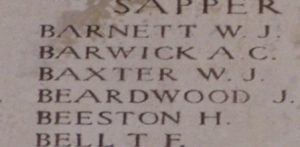
William John Burford, Corporal. William cannot presently be identified but he possibly died in 1917.
Frank Clayton, Private, 131030, Machine Gun Corps. Frank was the son of David and Bridget Clayton, of 3, Phoenix Cottages, Llanidloes. He married Violet Elizabeth Chapman at Llandinam on 5 November 1914 and two months later violet gave birth to their only child, a daughter, Hilda. Frank enlisted into the army and trained as a specialist machine-gunner, before being posted to A Company, 38th Battalion, Machine Gun Corps. The battalion had been formed in France in February 1918, attached to the 38th (Welsh) Division, and had been formed by the merging of the personnel of the various Machine Gun Company’s within the Division. The Division had wintered in the Sailly-sur-la-Lys sector after being relieved from Ypres in September 1917, and had moved to positions north of Albert, at Bouzincourt Ridge, at the end of March 1918, relieving the battered 2nd and 47th Divisions. It held this sector, carrying out minor operations and trench raids, over the coming months, before taking part in the great offensive of 21 August 1918, and began its advance towards the Hindenburg Line. Over the coming weeks the Division crossed the old Somme battlefields of 1916, clearing Pozieres, Longueval and Morval before taking Sailly-Saillisel and crossing the Canal du Nord. Once the Hindenburg Line had been smashed, the Division continued its advance, sweeping past Le Cateau to the mighty Forest of Mormal, and by the time the Armistice was signed had reached Écuélin. Frank was taken ill just after the Armistice and died of broncho-pneumonia at the 19th Casualty Clearing Station at Caudry on 26 November 1918. The 26-year-old was buried in Caudry British Cemetery, France.
John Byrnes Davies, Gunner, 70005, Royal Garrison Artillery. John was the son of John and Elizabeth Davies, of 13, Brook Street, Llanidloes. He worked as a Grocers Assistant at Cwmavon prior to enlisting into the Royal Garrison Artillery at Port Talbot on 14 December 1915 and was initially placed on the Army Reserve. John was mobilised on 29 February 1916 and was posted to No 2 Depot, RGA at Pembroke Dock for training. John was then posted to the 262nd Siege Battery, RGA. The battery assembled at Bristol, entraining for Folkestone and John embarked for France with the battery aboard the SS Princess Victoria on 10 February 1917, disembarking at Boulogne on the following day. An advance party from the Battery then entrained for Arras, while the bulk of the battery awaited the arrival of their guns and equipment, before moving by motor lorry to Doullens. By 1 March 1917 the Battery had reached Dainville, on the Arras to Doullens road, and began setting up its gun positions, in preparation to take provide artillery support for the forthcoming Battle of Arras. The battle was planned to open on 9 April 1917, and the 262nd Siege Battery started its preliminary bombardment upon strategic targets some five days before, firing hundreds of rounds daily onto positions on the Hindenburg Line. This work continued until the cessation of the Arras offensive on 16 May, then the 262nd Siege Battery packed up and moved to Godewaersvelde, to prepare for the forthcoming Battle of Messines Ridge, setting up its gun batteries at Kemmel, and began targeting German anti-tank emplacements and strongpoints, leading up to the opening assault on Messines Ridge on 7 June. Following the closure of the offensive on 14 June, the battery moved further north to set up at Vlamertinghe, in order to carry out further work ‘softening-up’ German defences on the Pilckem Ridge, in preparation for the forthcoming Passchendaele offensive. The Battery was at work on 25 July 1917 shelling the German lines when it came under fire by German counter-battery fire. John and three other men were killed, while another 13 men were wounded, two dying soon afterwards. John was 30 years old when he was killed that day, and is buried in Vlamertinghe New Military Cemetery, Belgium.
Rees Davies, Private, 25804, Lancashire Fusiliers. Rees was born in Llanidloes in 1889. He was raised by his aunt, Emily Worthing, at The Old Workhouse, Llanidloes, but by 1911 was lodging with the Owen family at 26, Smithfield Road, and worked in the town as a butcher. Rees married Mary Jane Owen, at Llanidloes in 1915. He enlisted into the army and was posted to the 12th Battalion, Lancashire Fusiliers. The battalion had moved to Salonika from France with 65 Brigade, 22nd Division in November 1915, and had served there until July 1918, when the Division returned to France, following the heavy losses suffered by the British during the German spring offensives. The 12th Lancashire Fusiliers then joined the 66th Division and on 13 August 1918 became absorbed by the 6th Battalion, Lancashire Fusiliers, which was billeted in Haudricourt in the same Division. After enjoying a prolonged rest period, on 19 September the 6th Lancashire Fusiliers entrained for Tinques, and marched to Lignereuil, then by 29 September reached Harbonnières, moving forwards to the fighting line over the coming days. The Division then moved to the Montay sector, taking part in the final actions of the war, during the Battles of the Selle and the Sambre. By Armistice Day, 11 November, the Division was in the area surrounding St. Hilaire-sur-Helpe, west of Avesnes. By the beginning of January 1919, the 6th Lancashire Fusiliers had been billeted in Onhaye, near Dinant, where demobilisation began. Rees took ill whilst stationed here and died of influenza on 26 February 1919. The 29-year-old was buried in Houyet Churchyard, Belgium.
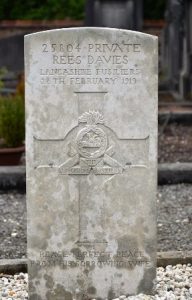
Thomas Emlyn Davies, Private, 57459, Royal Welsh Fusiliers. Thomas was the son of Thomas and Sarah Davies, of 60, High Street, Llanidloes. He enlisted at Welshpool into the Montgomeryshire Yeomanry, and probably trained at Park Hall Camp, Oswestry, before being posted to France in the late summer of 1917, joining the 13th Battalion, Royal Welsh Fusiliers. The battalion was attached to 113 Brigade, 38th (Welsh) Division, and on 31 July 1017 had taken part in the opening offensive of the Third Battle of Ypres, the assault on the Pilckem Ridge, seizing its objectives and reaching the Steenbeek, facing Langemarck. The Division then saw further fighting during the Battle of Langemarck over the coming weeks. Thomas probably joined the 13th RWF as it rebuilt and refitted after the battle. The Division was transferred to the Sailly-sur-la-Lys sector, with the 13th RWF marching to Elverdinghe on 10 September, entraining at International Corner Station, and by 17 September had taken over positions in the Bois Grenier Sector. The infantry battalions of the division then began to carry out the usual routines of trench rotation, which usually comprised spending four days in the front line, four in support and four in reserve. On 10 November 1917 the 13th RWF relieved the 16th RWF in the front line in the left sub-sector of the Bois Grenier Sector, to begin a routine tour in the line. On 14 November 1917 the 13th RWF sent out a fighting patrol of two officers, two sergeants and 19 other ranks, ordered simply to kill Germans. As the patrol crossed No Man’s Land, they came under heavy fire from a German patrol which had been waiting to ambush them, and the patrol was forced to withdraw after suffering several casualties. Thomas was killed during the brief encounter that day. His body was brought back from No Man’s Land, and the 18-year-old was buried in Erquinghem-Lys Churchyard Extension, France.
Moses Dykes, Private, 290180, Royal Welsh Fusiliers. Moses was born in Liverpool on 27 May 1891, the son of Thomas and Sarah Dykes. The family had moved to Bethel Street, Llanidloes prior to 1901. Moses worked as a Fitter at the J. Mills Foundry, Llanidloes prior to enlisting into the 7th Battalion, Royal Welsh Fusiliers in 1908 and had served for three years prior to leaving the battalion in 1911. Moses then re-enlisted into the 7th Battalion, Royal Welsh Fusiliers at Llanidloes on 7 April 1914. The battalion was a Territorial unit, which mobilised for war at Newtown in August 1914, as part of North Wales Brigade, Welsh Division and moved to Conway until the end of the month, before moving to Northampton. In December the Division moved to Cambridge and then in May 1915 to Bedford, where the Division was numbered and the formation became 158 Brigade, 53rd (Welsh) Division. On 19 July 1915 the entire Division sailed from Devonport for Imbros and on 9 August 1915 landed at Suvla Bay. The infantry moved off the beaches into the bush, but due to a lack of maps and no knowledge of the terrain, many of the units became disorientated, and the situation became chaotic. After the fighting died down, the winter rolled in, and the men first had to endure torrential downpours, which flooded the trenches, before the snow hit, and many men began falling ill in the terrible conditions. The Division was eventually evacuated from Gallipoli in December 1915, moving to Egypt to join the EEF, and helped guard the Suez Canal before taking part in operations to drive the Turks out of the Sinai. The EEF then turned its attention onto driving the Turks out of Palestine, and on 26 March 1917 launched its first offensive against the coastal city of Gaza, which guarded the road to Jerusalem. Initial gains during the day were lost when the assaulting divisions lost touch with each other and communication broke down when a thick fog cloaked the battlefield. Moses had been killed in action at some time during the day. The 25-year-old has no known grave and is commemorated on the Jerusalem Memorial, Israel. One of his brothers, Thomas, had been killed in France soon after the outbreak of war.
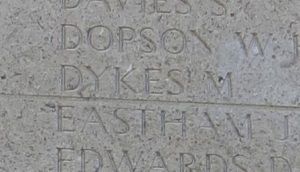
Thomas Dykes, Private, 7827, South Wales Borderers. Thomas was born in Liverpool in 1883, the son of Thomas and Sarah Dykes. The family had moved to Bethel Street, Llanidloes prior to 1901. Thomas was working as a quarryman at Dowlais by 1911, and married Annie Price later that year. The couple resided in 49, Mount Pleasant Street, Dowlais. Thomas had enlisted into the 1st Battalion, South Wales Borderers at some time prior to the war. The battalion was at Bordon attached to 3 Brigade, 1st Division when war was declared, and landed at Le Havre on 13 August 1914 with the BEF. The Division then moved with the BEF to the Belgian frontier, around the city of Mons, where the BEF saw its first major action on 23 August following the German invasion of lowlands. The BEF and the French were vastly outnumbered, and began to withdraw south the following day, sweeping around the Forest of Mormal, and then fought a brave action during the Battle of Le Cateau, before continuing the withdrawal south over the coming two weeks. There was further fighting at Néry, where L Battery, Royal Horse Artillery put on a stubborn fight, coupled with several minor engagements, before the BEF reached the River Marne, and the retreat was halted and the German assault was stopped. On 6 September the British and French launched a successful assault across the Marne, which drove the Germans back towards the Aisne valley, then on 13 September the BEF launched another assault in conjunction with the French, the Battle of the Aisne, which ultimately halted the German drive on Paris and forced the Germans to look further north. The BEF then moved north to Flanders, to guard the city of Ypres, whilst for now the 1st SWB remained at Vendresse, awaiting orders to move north. Thomas was killed here by German shellfire on 14 October 1914, just two days prior to the battalion entraining for northern France. The 31-year-old has no known grave and is commemorated on the La Ferté-Sous-Jouarre Memorial, France. One of his brothers, Moses, was killed at Gaza in 1917.
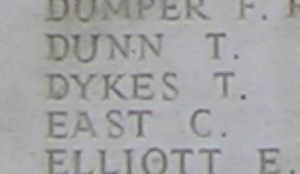
Harold Henry East, Private, 239021, Herefordshire Regiment. Harold was born in Llantrisant in 1885, the son of Edwin and Laura East. He married Edith Emily Jones, of Llanidloes, in 1916. The couple briefly resided at Dyfnant, Queen’s Terrace, Aberystwyth. Harold enlisted at Hereford into the Herefordshire Regiment, and Edith moved back to Llanidloes. Harold was drafted Egypt early in 1916, and was posted to the 1st/1st Battalion, Herefordshire Regiment. The battalion was a Territorial unit which had mobilised at Hereford on 4 August 1914, attached to the Welsh Border Brigade, Welsh Division. The Division initially moved to its war station at Pembroke Dock, but soon moved via the Wellingborough area to Bury St. Edmunds, and then to Bedford, where the Division was numbered the 53rd (Welsh) Division. The Division had fought throughout the Gallipoli campaign in 1915, until its evacuation in December 1915, moving to Egypt to join the EEF, and helped guard the Suez Canal before taking part in operations to drive the Turks out of the Sinai. The EEF then turned its attention onto driving the Turks out of Palestine, and on 26 March 1917 launched its first offensive against the coastal city of Gaza, which guarded the road to Jerusalem. Initial gains during the day were lost when the assaulting divisions lost touch with each other and communication broke down when a thick fog cloaked the battlefield. A second attempt to force Gaza was launched on 17 April, which also failed, and the EEF suffered a change in leadership, with Sir Edmund Allenby assuming command, before being re-organised, and a third offensive was launched against a wider front from Beersheba to Gaza on 31 October 1917. This time the Turkish defences were breached, and the road to Jerusalem now lay open and the EEF began to advance north. On 6 November 1917, 158 Brigade launched an attack on the Khuweilfeh Heights. Harold was killed in action during the assault that day. The 32-year-old is buried in Beersheba War Cemetery, Israel.
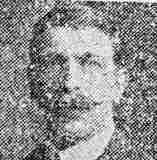
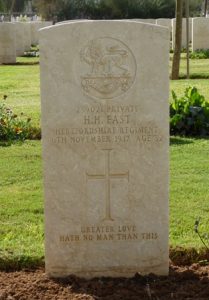
David Hubert Evans, Private, 50167, Welsh Regiment. Hubert was born at Llanidloes in 1888, the eldest son of Richard and Annie Evans. The family later resided at Madoc House, Queens Road, Aberystwyth. David enlisted at Cardiff into the Welsh Regiment and served on the Western Front from early in 1917 with one of the Service Battalions of the regiment. Hubert was invalided home from France and after recovering was stationed at Redcar, Yorkshire, with the 3rd Battalion, Welsh Regiment. It was there that he contracted pneumonia and died on 16 January 1918 at Red Barnes Hospital, Redcar, his parents being present at his death. His remains were brought home to Aberystwyth by Sergeant Herbert, of the 3rd Welsh, before burial in Dolhafren Cemetery, Llanidloes. David is not commemorated on the Llanidloes war memorial, but at St. David’s Church, Aberystwyth.
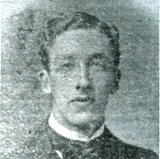
Guy Everingham, Second Lieutenant, Royal Flying Corps. Guy was born in Barry, South Wales on 28 June 1894, the son of William Everingham and Patricia Florence Everingham (nee Davenport). The family then moved to Vaenor Park, Llanidloes, where Everingham and his younger brother Robin were raised, and had another residence at Vaenor, Hawarden Road, Colwyn Bay. Guy enlisted into the 13th RWF in October 1914 and was soon commissioned on 25 February 1915 and joined the battalion in France in March 1916. He saw action during the assault on Mametz Wood that year and when the 38th (Welsh) Division moved to Ypres he volunteered to join the Royal Flying Corps, training as an observer. Guy married Gladys Annie Brown, of Lynwood, St. David’s Place, Llandudno while on leave on 19 February 1917 before returning to France with 16 Squadron. On 8 April 1917, Bloody April as it was known among the RFC, Guy was flying as observer to Second Lieutenant Keith Ingleby in B.E.2e serial A2815, on a photographic reconnaissance over Vimy Ridge when they were attacked by Manfred von Richthofen, the Red Baron. At 4.40 pm their aircraft came hurtling into the ground behind German lines, killing both men. Guy was 22-years-old and is buried next to Ingleby in Bois-Carré British Cemetery, Thelus. His brother Robin (1098) was killed at Gallipoli with the Welsh Horse in 1915.
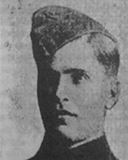
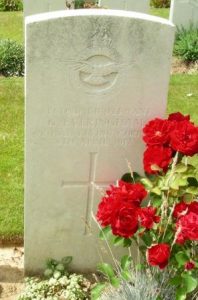
Robin Everingham, Private, 1098, Welsh Horse Yeomanry. Robin was born at Barry, South Wales on 25 May 1896, the son of William Everingham and Patricia Florence Everingham (nee Davenport). The family then moved to Vaenor Park, Llanidloes, where Everingham and his younger brother Robin were raised, and had another residence at Vaenor, Hawarden Road, Colwyn Bay. Robin and his brother Guy were privately educated, but Robin went to sea as a young man, and was completing his fourth year under navigational studies aboard the SS Pentwyn, when war was declared. Robin then returned to Britain from South America aboard Pentwyn, before the ship was requisitioned for use by the Admiralty, and he was serving aboard her when the ship transported heavy guns of the Royal Artillery to Belgium. He remained in Belgium for a short while, enlisting into the Belgian Army, and was attached to the Legion of Frontiersmen, before being attached to the 3rd Belgian Lancers. He was wounded during fighting on the Yser in December 1914 and returned to England for treatment. Upon his recovery he volunteered into the Welsh Horse Yeomanry in March 1915. The battalion had formed in Glamorgan, before being transferred to the Montgomeryshire T.F. Association with its headquarters at Newtown. By early 1915 the Welsh Horse joined the 1/1st North Midland Mounted Brigade of 1st Mounted Division in the Diss area of Norfolk, then in February 1915 transferred to the 1/1st Eastern Mounted Brigade, 1st Mounted Division in the Woodbridge area. In September 1915 the Welsh Horse dismounted and sailed from Liverpool aboard the SS Olympic on 25 September, landing at Anzac Cove, Gallipoli on 10 October, joining the 54th (Lowland) Division. The Welsh Horse was then utilised as a Pioneer unit, and began work mining in the Hill 60 sector, beneath the Turkish positions. Robin was killed by machine-gun fire on 10 December 1915, just moments after shooting a Turkish sniper. The 19-year-old is buried in 7th Field Ambulance Cemetery, Gallipoli. His brother Guy was killed at Arras in 1917.
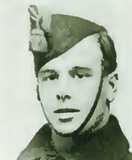
Joseph Frank, Sergeant, 8624, Welsh Regiment. Joseph was born at Penygraig, Rhondda in 1881. He was a regular soldier, and embarked for France with the 2nd Battalion, Welsh Regiment on 13 August 1914. The battalion was attached to 3 Brigade, 1st Division, and had been one of the first to arrive in France, fighting at the Battle of Mons, and taking part in the retreat to the Marne, where the Germans were stopped. The Division then fought at the Aisne, and in a famous action at Chivy Ridge, where William Fuller of the 2nd Welsh gained the Victoria Cross, before being moved north to defend the city of Ypres. The Division had then played a vital role in stopping the Germans capturing the important city, during the First Battle of Ypres, where the 1st Division made a famous stand at Gheluvelt, where the 2nd Welsh and 1st SWB were virtually annihilated. Joseph must have been wounded at Ypres and returned to Britain. He married Elizabeth Lloyd (nee Owen), a widow, of 30, Smithfield Road, Llanidloes whilst on leave in 1915. Upon his return to France, Joseph joined the 1st Battalion, Welsh Regiment, which was attached to 84 Brigade, 28th Division. The Division had formed in England between December 1914 and January 1915 from regular units returning from India, Singapore and Egypt. During January 1915 it moved to France, landing at Le Havre and moved to the Western Front, where it saw its first major action during the Second Battle of Ypres. The battle was launched by the Germans on 22 April 1915, when they released 171 tonnes of chlorine gas along a four-mile front between the hamlets of Langemarck and Gravenstafel, which was being held by French Colonial troops. The French suffered terrible casualties and the survivors fled in horror, opening up a gap in the line. The Canadian Corps was rushed forwards to plug the gap, and heavy fighting ensued. The 1st Welsh, in the meantime, had been holding the line near Broodeseinde, but on the following night was relieved. The battalion was supposed to have gone into reserve, but was moved into the line at Frezenberg, which it held over the coming days as fighting raged to the north. The 1st Welsh were fortunate in that the battalion was relieved on 5 May, just before the Germans attacked Frezenberg, but still suffered heavy casualties from shelling. On 8 May the 28th Division was almost annihilated, forcing the remnants to withdraw to Bellewaarde Lake to form a new line. The Germans launched another gas attack on 24 May, and the remnants of the 28th Division were moved back into the line to launch a counter-attack upon Bellewaarde Ridge. Joseph was killed in action during the assault on 25 May 1915. The 34-year-old has no known grave and is commemorated on the Ypres (Menin Gate) Memorial, Belgium.
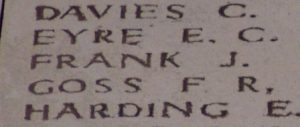
Arthur Llewelyn George, Private, 029703, Royal Army Ordnance Corps. Arthur was the son of Thomas George and Sarah George (nee Edwards), of Hafren House, Llanidloes. He enlisted into the Army Ordnance Corps and was posted to the Middle East with the 11th Company, AOC. The Army Ordnance Corps was transformed following the outbreak of war, expanding from its original depots at Woolwich, Weedon and Pimlico by the takeover of warehouses throughout the country, as well as several new purpose-built facilities. The task of the AOC was simple, yet complex: In the supply area it had responsibility for weapons, vehicles and other military equipment, ammunition and clothing and certain minor functions such as laundry, mobile baths and photography, as well as being responsible for a major element of the repair of Army equipment. The job of the 11th Company, AOC, to which Arthur had been posted, was to supply the EEF, during its long and arduous campaign in the Sinai and Palestine. After the Armistice, in recognition of the service of the AOC, it was awarded the prefix Royal, becoming the Royal Army Ordnance Corps. Arthur was still in Egypt when the honour was granted, and was still serving on the Suez Canal. He became ill before demobilisation, and died at Suez on 26 June 1919. The 21-year-old is buried in Suez War Memorial Cemetery, Egypt.
Richard Osborne George, Private, 49634, Royal Welsh Fusiliers. Richard was the son of Evan George and Mary Jane George (nee Meredith), of 10, Church Street, Llanidloes. He worked as a lead miner prior to enlisting into the 7th Battalion, Royal Welsh Fusiliers at Llanidloes on 16 May 1912, and attended the annual TA summer camp over the coming years. Following the outbreak of war, the battalion was mobilised, and moved to Northampton. Richard, however, was among a number of surplus men posted to the 3/7th Battalion, Royal Welsh Fusiliers, at Park Hall Camp, Oswestry. On 27 June 1916 he embarked at Devonport among a number of drafts posted to Egypt to join the 1/7th Battalion, Royal Welsh Fusiliers, which by then was on the Suez Canal Defences, attached to 158 Brigade, 53rd (Welsh) Division, and he disembarked at Alexandria on 9 July, joining the battalion five days later. He had been in Egypt less than two months when he dislocated his humerus and was hospitalised at the 26th Stationary Hospital. He was discharged two weeks later and returned to duty, but on 22 November 1916 took ill and taken to the 26th Stationary Hospital again. Richard was discharged from hospital and re-joined the battalion at Cairo on 20 December. He would have taken part in the First and Second Battles of Gaza with the battalion the following year, but in the summer his health deteriorated, and on 20 August 1917 he was hospitalised again at Alexandria, suffering from bronchial catarrh, but was found to have contracted tuberculosis. On 24 October Richard was evacuated to Britain aboard the Hospital Ship Kalyan and was sent to the 1st Southern General Hospital at Birmingham for treatment before being discharged from the army as medically unfit on 13 December 1917. He was then sent to a Sanatorium in South Wales, where he died of tuberculosis on 7 February 1918, aged 32. Richard’s remains were conveyed home for burial in Dolhafren Cemetery, Llanidloes.
Herbert John Goodall, Private, 52655, Royal Army Medical Corps. Herbert was born on 5 June 1895, the son of Charles and Jane Elizabeth Goodall, of 48 Balance Street, Uttoxeter. He moved to Llanidloes in 1913 to work as a Postman. Herbert enlisted into the Royal Army Medical Corps at Uttoxeter soon after the outbreak of war and embarked for Egypt on 27 July 1916. He served in Egypt for several months before being transferred to France, and was posted to the 11th Casualty Clearing Station at Bailleul. Bailleul became a very busy Hospital soon after Herbert’s arrival, as the Allies were building up forces nearby in preparation to launch the Battle of Messines Ridge, and as a result, the Hospital had been building up its staffing levels in preparation to cope with the expected high number of casualties. On the night of 6-7 July 1917, the Germans went against all civilised protocol and attacked Bailleul with a number of aircraft, dropping a number of bombs onto the Hospital, which killed 25 people and wounded a further 65. The cases were taken to the dressing hut, and after being dressed twenty wounded were sent to 2nd Casualty Clearing Station in the town. Herbert was too badly wounded to move and died of his wounds at the 11th Casualty Clearing Station later that day, 7 June 1917. The body of the 21-year-old was laid to rest alongside a number of other casualties of the air raid in Plot III, Row D in Bailleul Communal Cemetery Extension, France.
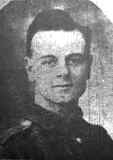
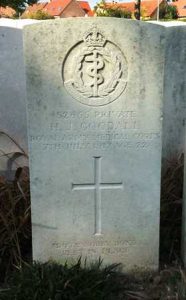
Albyn Evan Powell Grant, Second Lieutenant, Royal Welsh Fusiliers. Albyn was the son of James Grant and Margaret Catherine Grant (nee Shepherd), of Glandwr, Llanidloes. He was educated at Shrewsbury School, where he was in both the Cricket and Football Elevens, and after graduating in 1912 became a Land Agent. Albyn enlisted into the Public Schools Battalion, Royal Fusiliers soon after the outbreak of war, and was commissioned as Second Lieutenant into the 7th Battalion, Royal Welsh Fusiliers on 12 January 1915. The battalion was a Territorial unit, which mobilised for war at Newtown in August 1914, as part of North Wales Brigade, Welsh Division and moved to Conway until the end of the month, before moving to Northampton. In December the Division moved to Cambridge and then in May 1915 to Bedford, where the Division was numbered and the formation became 158 Brigade, 53rd (Welsh) Division. On 19 July 1915 the entire Division sailed from Devonport for Imbros and on 9 August 1915 landed at Suvla Bay. The infantry moved off the beaches across the Salt Lake, under shellfire, into the scrub covered Chocolate Hill, but due to a lack of maps and no knowledge of the terrain, many of the units became disorientated, and the situation became chaotic. Albyn survived the initial chaos, but the situation got no better over the coming days and he was posted as missing, believed killed in action on 14 August 1915. The 22-year-old has no known grave and is commemorated on the Helles Memorial, Gallipoli.
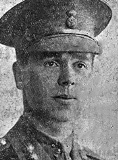
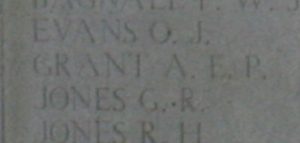
Thomas Henry Habberley, Private, 6334, Royal Welsh Fusiliers. Thomas was the son of Charles and Margaret Habberley, of Barrow, Shropshire. He had enlisted into the 1st Battalion, Royal Welsh Fusiliers on 5 February 1900, and had served with the battalion in South Africa during the Anglo-Boer War. Thomas had completed eight years’ service, mainly in India, before leaving the army, and moved to Newtown where he worked as a Butler for Mr Phillips at Plas Cae Crwn. He married Mary Elizabeth Edwards on 30 January 1911 and the couple moved to Llanidloes prior to the war, where Thomas gained a position as a Postman in the town. As an Army Reservist, Thomas was mobilised as soon as war was declared, attesting again at Wrexham on 4 August 1914 and was initially posted to the 3rd Battalion, Royal Welsh Fusiliers. He embarked for France on 20 October 1914, joining the 1st Battalion, Royal Welsh Fusiliers, which was at Ypres attached to 22 Brigade, 7th Division. The Division was embroiled in heavy fighting, during the First Battle of Ypres, when Thomas joined the ranks of the 1st RWF. After the fighting calmed down, the battalion wintered in the Ypres Salient, and on 10 March 1915 saw its next major action during the Battle of Neuve Chapelle. After suffering heavy losses, the battalion was relieved and moved into billets at Fort D’Esquin, to rest and refit. By 7 April the 1st RWF had moved to reserve billets at Rue du Bacquerot, and four days later relieved the Royal Scots in the trenches to begin a routine tour in the line, being relieved on 14 April. The battalion enjoyed another period out of the line until 6 May, when it moved forwards again, to take part in the Battle of Aubers Ridge, where the Division launched an assault against the village of Aubers on 9 May 1915. The 1st RWF remained in the assembly trenches, in support of the assault, but the attacking troops made no gains, so the battalion was not called upon, and marched to billets in Essars. On 15 May 1915 the 7th Division took part in another assault, against the village of Festubert. The 1st RWF attacked on the following day, 16 May 1915, ordered to seize the line running from the Rue Quinque to Rue D’Ouvert. The battalion seized the German front and second lines, but suffered terrible losses in doing so. Thomas was killed in action during the assault that day. The 34-year-old has no known grave and is commemorated on the Le Touret Memorial, Richebourg-L’avoue, France. His widow, Mary, later moved to Coventry with their three children and remarried.
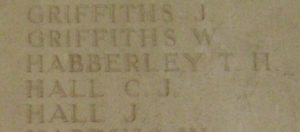
Harry Halford, Private, 6496, Scots Guards. Harry was born at Cheltenham in 1886, the son of Harry and Fanny Halford. His mother was from Shrewsbury, and the family moved there by 1891, before moving to Llanidloes by 1901. Harry was a regular soldier, who enlisted into the Scots Guards soon after turning 18, and by 1911 was stationed in Kasr-el-Nil Barracks, Cairo with the 1st Battalion, Scots Guards. By the time war was declared, Harry was with the 1st Scots Guards at Aldershot, where the battalion was attached to the 1st (Guards) Brigade, 1st Division. On 14 August 1914 the Division landed at Le Havre, moving to the Belgian Frontier with the BEF and set up in positions near the city of Mons. The 1st Division had been one of the first to arrive in France, fighting at the Battle of Mons on 23 August 1914, before taking part in the epic retreat to the Marne over the coming fortnight, until stopping the Germans on the River Marne. The 1st Division then advanced with the BEF in conjunction with the French and saw heavy fighting against the Germans in the Aisne valley, stopping the German drive on Paris and forcing the Germans to dig in along the Chemins-des-Dames ridge. This set in motion a period of the war later known as ‘The Race to the Sea’, where both sides attempted to outflank each other towards the Channel coast. The instigator of this was the movement of the BEF to the Ypres Salient in October 1914, where it dug in to the east of the ancient city of Ypres, alongside the French and Belgians. On 20 October 1914 the Germans attacked the thinly held line, heralding the opening of the First Battle of Ypres, and the terrible fighting raged until 22 November, when the German attacks ceased. Harry was wounded at Ypres, and was evacuated to No 2 Stationary Hospital, Le Havre, where he died of his wounds on 25 November 1914. The 28-year-old is buried in Boulogne Eastern Cemetery, France.
Thomas John Hamer, Private, 260087, Cheshire Regiment. Thomas was born at Llanidloes in 1898, the son of Richard Hamer and Mary Hamer (nee Davies). The family had moved to 1, Augusta Street, Ton Pentre by 1908, after Richard had found work there as a builder’s haulier. Thomas enlisted into the Monmouthshire Regiment at Pentre, Rhondda soon after the outbreak of war. He was drafted to France early in 1917, where he was initially transferred to the 5th Battalion, Cheshire Regiment. The battalion was the Pioneer Battalion to the 56th (London) Division and had moved to the Arras Sector from Laventie in the first week of March 1917, to prepare for the forthcoming Arras offensive. Soon after this, Thomas was transferred to the 11th Battalion, Cheshire Regiment, which was attached to 75 Brigade, 25th Division. The Division was in the Ypres Salient during March 1917, stationed near Neuve Eglise and Steenwerck, holding a section of the line at Ploegsteert Wood, where it was preparing to take part in the forthcoming Battle of Messines Ridge. The assault on Messines Ridge was launched at dawn on 7 June 1917 and heralded by the blowing of a series of 19 (21, but two did not explode) vast underground mines beneath the German positions. The infantry then attacked, supported by tanks, and captured the German lines running from Messines and Wytschaete to Mount Sorrel over the coming days, laying the foundation for the forthcoming Third Battle of Ypres. After successfully participating in the Messines offensive, the 25th Division then moved to the Zillebeke Lake area, to prepare to take part in this next offensive, with the 11th Cheshire’s reaching Dominion Camp, near the lake, by 9 July. A large working party from the battalion was then despatched to assist the work of the 171st Tunnelling Company. Thomas was killed in action here, probably whilst working with the Tunnellers, on 13 July 1917. The 19-year-old is buried in Voormezeele Enclosure No. 3, Belgium. Thomas is not commemorated on the Llanidloes war memorial.
Thomas Pryce Hamer, Lieutenant, South Wales Borderers. Thomas was the son of Edward and Martha Hamer, of Summerfield Park, Llanidloes. He was a local celebrity prior to the war, and played association football for Llanelli for two seasons, and had represented Wales at international level, as well as being a wealthy industrialist. He was commissioned on 1 April 1915, and joined the 11th Battalion, South Wales Borderers in France, which was attached to 115 Brigade, 38th (Welsh) Division. The Division had landed in France during December 1915 and had spent their first winter in the trenches near Armentieres. In June they marched south to the Somme, where they were tasked with the capture of Mametz Wood. The attack on the wood began on 7 July, but met with fierce resistance, and it took until 14 July to totally clear the wood. Thomas was killed during the first attack on the Wood, on 7 July 1916. He was 33 years old, and is commemorated on the Thiepval Memorial, France.
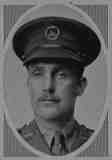
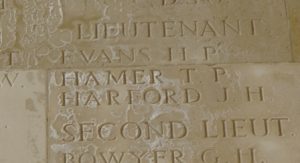
Percy Ward Heaven, Private, 4300, Welsh Regiment. Percy was the son of John and Lucy Heaven, of Bath Road, Stroud. He married Mary Jane Jones at Llanidloes in 1908, and the couple lived there for two years before moving to 5, Southern Terrace, Carmarthen. Percy worked at the New Dinant Colliery, at Tumble prior to the war. He had already served for a while with the 7th Battalion, Royal Welsh Fusiliers (Territorials) prior to moving to Carmarthen. Percy re-enlisted at Carmarthen into the 4th Battalion, Welsh Regiment soon after the outbreak of war. The battalion was the local Territorial unit and mobilised for war at Carmarthen in August 1914, as part of South Wales Brigade, Welsh Division and moved to Tunbridge Wells until the end of the month, before moving to Scotland to man the Forth and Tay Defences. On 17 April 1915 the battalion moved to Bedford, joining 158 Brigade, 53rd (Welsh) Division. On 19 July 1915 the entire Division sailed from Devonport for Imbros and on 9 August 1915 landed at Suvla Bay. The infantry moved off the beaches across the Salt Lake, under shellfire, into the scrub covered Chocolate Hill, but due to a lack of maps and no knowledge of the terrain, many of the units became disorientated, and the situation became chaotic. Percy was killed in action here on 10 August 1914. The 26-year-old has no known grave and is commemorated on the Helles Memorial, Gallipoli. His widow and their four young children later moved back to 16, Brook Street, Llanidloes.
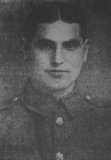
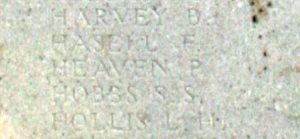
Frederick Henry Hill, Private, 56987, Welsh Regiment. Frederick was born in Tonypandy in 1888. He married Sarah Jane Edwards, of 11, Penygraig Street, Llanidloes on 4 August 1913. Frederick enlisted into the Montgomeryshire Yeomanry at Llanidloes on 27 April 1914 and attended the annual TA summer camp that year. He was mobilised with the regiment on 5 August 1914 and posted to Norfolk. Frederick deserted from the regiment and on 29 December 1915 he enlisted into the 3/7th Battalion, Royal Welsh Fusiliers, which was at Park Hall Camp, Oswestry training. On 10 January 1916 he was arrested for having fraudulently enlisted into the battalion, as he was still serving with the Montgomeryshire Yeomanry, and was forced to forfeit his previous service. On 8 August 1916 Frederick was drafted to France, where he was transferred to the 4th (Reserve) Battalion, Welsh Regiment, and was then posted to the 10th Battalion, Welsh Regiment, which was in the Ypres Salient, holding the Canal Bank Sector at Boesinghe, attached to 114 Brigade, 38th (Welsh) Division. The Division had moved there following its famous assault on Mametz Wood in July 1916. The infantry battalions of the Division then began carrying out the normal pattern of rotation in the trenches, four days in the front, four in support and four in reserve, whilst also working on trench improvement, digging new trenches, and also carrying out regular patrols and trench raids. On 31 July 1917 the Division launched its famous assault on the Pilckem Ridge, capturing Iron Cross and reaching its objective of the Steenbeek, then played a supporting role in the Battle of Langemarck. The Division was transferred to the Sailly-sur-la-Lys sector in September and remained in the area over the winter. The 10th Welsh was among a number of British battalions disbanded during to the restructuring of the army in France in February 1918, and Frederick was initially posted to the 1st Entrenching Battalion. On the following month, 21 March 1918, the Germans launched a massive assault along the section of front line running south from Croisilles to La Fère, and amongst the units badly hit was the 9th Battalion, Welsh Regiment, of 58 Brigade, 19th (Western) Division. The battered Division was withdrawn from the Somme at the end of March and moved north to the Wytschaete Sector to rest and refit, and Frederick was among a large number of men posted to the 9th Welsh upon its arrival. On 9 April 1918 the Germans launched the second phase of their offensive in this area, in the Lys Valley, and on the following morning the battered 19th Division was thrown into desperate fighting once more. Heavy fighting raged over the coming days as the Allies were pushed back, the 19th Division in the direction of Bailleul. Frederick was killed in action near Wulverghem on 16 April 1918, just before the 9th Welsh was moved out of the line. The 29-year-old has no known grave and is commemorated on the Tyne Cot Memorial, Belgium.
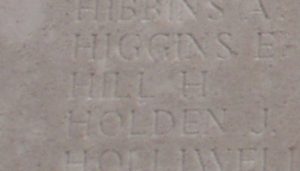
Albert Henry Hopper, Lance Sergeant, 16570, Royal Welsh Fusiliers. Albert was the son of George Hopper and Annie Hopper (nee McGuire), of 6, Station View, Llanidloes. He enlisted into the Royal Welsh Fusiliers soon after the outbreak of war and was posted to the 9th Battalion, Royal Welsh Fusiliers. The battalion had formed at Wrexham in September 1914, before moving to Tidworth to join 58 Brigade, 19th (Western) Division. On 19 July 1915 Evan landed in France with the battalion, and the entire 19th Division then moved to the Nursery Sector at Calonne for trench initiation alongside the Dehra Dun Brigade. The infantry battalions of the division then began carrying out the usual routines of rotating in the trenches: four days in the front line; four in support; and four in reserve, interspersed with training regimes and carrying out working parties and trench raids. Just south, the British launched a great offensive around the town of Loos on 25 September 1915, and the 19th Division was ordered to attack from its positions at the same time, to attempt to draw enemy attention away from the main battle area. The attacking battalions of the 19th Division were in place by 04.00, and then at 05.50 the men climbed out of their trenches to launch their assault, behind a gas and smoke screen. The assault was a disaster, and heavy casualties were suffered by the 19th Division for no gain. The Division wintered on the Somme and in February followed the German withdrawal to the Hindenburg Line. During the middle of March 1917, the Division was relieved from the line and began to move north, taking over positions in the Ypres Salient, and on 7 June took part in the assault on Messines Ridge, which was famously preceded by the blowing of a series of 19 huge underground mines. The 19th Division saw heavy fighting during the battle, then enjoyed a short spell in reserve before moving back into the line on 11 September, taking over a section of trenches running from the Ypres-Comines Canal to Belgian Wood. On 20 September the 9th Welsh took part in an attack by the Division, past Hollebeke Chateau, to Hessian Wood. The 9th Welsh alone suffered around 300 casualties during the costly attack. The Division wintered in the Cambrai sector, following the closure of the Battle of Cambrai, and was holding a section of the line in the Flesquières Salient. On 21 March 1918 the Germans launched the first of three offensives on to the section of the front running from Flesquières to St. Quentin, and the 19th Division was thrown into desperate fighting as it was pushed back over the coming days. The battered Division was then moved to the Messines sector to rest, but on 11 April became caught up in the second phase of the German offensive, which had been launched along the Lys Valley on 9 April, and again became caught up in desperate fighting. The remnants of the Division were moved south to the Aisne sector to rest and rebuild, but by sheer bad luck, the Germans third, and last, offensive was launched here on 27 May 1918, and the Division was once more caught up in desperate fighting. Albert was captured by the Germans during one of the epic defensive battles fought during 1918 and was taken to a PoW camp at Minden in Germany. He became ill whilst in captivity and died at Minden on 26 October 1918. The 24-year-old is buried in Hamburg Cemetery, Germany. One of his brothers, George, had been killed at sea in 1917.
George Hobday Hopper, Leading Stoker, K/1099, Royal Navy. George was born at Talgarth, Breconshire on 9 May 1888, the son of George and Annie Hopper. By 1891 the family had moved to 6, Station View, Llanidloes. George worked as a lead miner prior to enlisting into the Royal Navy on 6 August 1908, signing up for twelve years. He was posted to Chatham for training before being posted aboard HMS Acheron on 6 August 1908. On 2 February 1909 he was transferred aboard HMS Implacable, then transferred between HMS Cyclops and HMS Pembroke II over the coming years. On 7 March 1916 George was posted aboard the newly launched Arabis-class minesweeping sloop, HMS Mignonette. Mignonette joined the Tenth Sloop Flotilla upon her completion in March 1916 and operated with them off the Irish Coast. Mignonette was at sea on 17 March 1917 when she struck a German laid mine off the coast of Ireland and sank. George was among fourteen men killed during her sinking. The 28-year-old is commemorated on the Chatham Naval Memorial, Kent. His youngest brother, Albert, died as a PoW in Germany in 1918.
David William Hughes, Private, 9359, Royal Welsh Fusiliers. David was the son of David and Sarah Ann Hughes, of 16, Penygraig Street, Llanidloes. He worked as a lead miner prior to enlisting into the 7th Battalion, Royal Welsh Fusiliers. He was posted to the 3/7th Battalion, Royal Welsh Fusiliers, at Park Hall Camp, Oswestry, and remained there until being posted to the 23rd Battalion, Royal Welsh Fusiliers at Hemsby in Norfolk. David was then posted to France, joining the 199th Prisoner of War Company, Labour Corps, and remained in France with the unit until after the Armistice. David took ill whilst still serving overseas and died of influenza at the 54th Casualty Clearing Station, Belgium on 23 February 1919. The 28-year-old is buried in Lijssenthoek Military Cemetery, Belgium.
John Gwilym Hughes, Lieutenant, Royal Welsh Fusiliers. John was the son of Thomas John and Mary Hughes, of Hazlewood, Bangor. He was educated at St Paul’s School and at Ysgol Friars, Bangor, before gaining his BA at the University of Wales, Bangor. John was a member of the University’s Officer’s Training Corps whilst at Bangor. He became a teacher after leaving University and became senior master at Llanidloes County School, where he became a member of the Llanidloes branch of the Honourable Society of Cymmrodorion. John left Llanidloes after gaining the post of assistant master at Ysgol Friars and helped organise the National Eisteddfod at Bangor in 1915. John left Bangor after gaining a commission as Second Lieutenant into the 20th Battalion, Royal Welsh Fusiliers in the autumn of 1915, and joined the battalion at Kinmel Park. John was drafted to France on 8 September 1916, and was posted to the 9th Battalion, Royal Welsh Fusiliers, which was attached to 58 Brigade, 19th (Western) Division. The Division was by then in the Ploegsteert Sector rebuilding, having suffered heavy casualties during the opening days of the Somme offensive from 1 July. On 19 September the Division was relieved, moving to Strazeele to rest, before returning to the Somme, entraining at Bailleul for Doullens on 5 October and marching to Toutencourt before taking over a section of the line at Regina Trench on 26 October. The 9th RWF came under heavy shellfire on the following day, whilst holding the trench, and John was evacuated wounded, suffering from shellshock. He was evacuated to hospital at Abbeville, where he died on 3 November 1916. The 35-year-old is buried in Abbeville Communal Cemetery Extension, France. He is also commemorated on the Bangor war memorial and at Ysgol Friars.
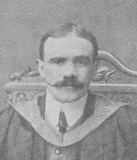
Leonard Roy Hughes, Private, 57269, Welsh Regiment. Leonard was born in Llanidloes in 1897, the son of James and Mary Hughes. The family moved to South Wales by 1911, and lived at 30, Morgan Terrace, Port Talbot. Leonard lived at 3, Talbot Road, Port Talbot prior to the war and worked as a Porter for the Port Talbot Railways and Docks Company. Leonard enlisted into the 7th (Cyclist) Battalion, Welsh Regiment at Port Talbot on 18 November 1915 and joined the battalion at Saltburn in Yorkshire, where it was carrying out garrison duties. On 29 July 1916 Leonard embarked at Southampton for France, disembarking Rouen the following day and joining the 6th Infantry Base Depot. On 5 August 1916 he was posted to C Company of the 13th Battalion, Welsh Regiment, which was by then at Wormhoudt. The battalion was attached to 114 Brigade, 38th (Welsh) Division and had just suffered terrible casualties during its assault on Mametz Wood the previous month and Leonard joined the battalion on the day that a memorial service was being held to commemorate those lost in Mametz Wood. On 14 August the Division moved to the Ypres Salient, having been allocated the Canal Bank sector at Boesinghe, north of the city of Ypres, and took over the front line. The infantry battalions of the Division then began carrying out the normal pattern of rotation in the trenches, four days in the front, four in support and four in reserve, whilst also working on trench improvement, digging new trenches, and also carrying out regular patrols and trench raids. Leonard was killed in action here on 13 October 1916 whilst on a working party, carrying out wiring. The 19-year-old is buried in Essex Farm Cemetery, Belgium. Leonard is not commemorated on the Llanidloes war memorial.
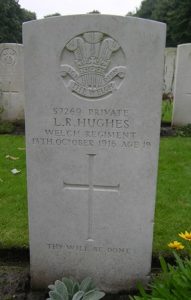
William Henry Humphreys, Rifleman, 532547, London Regiment. William was the son of John and Jane Humphreys, of The Gables, Llanidloes. He was educated at Llanidloes County School before going into business in Oldham. William enlisted into the London Regiment at Bristol soon after the outbreak of war, and whilst based in Winchester early in 1916, married Thelma McQuinn, of 84, Ashridge Street, Runcorn, Cheshire. Their only child, William Henry Humphreys, was born in Runcorn on 27 June that year. William embarked for France on 21 June 1916 and was posted to the 1/5th Battalion, London Regiment (Civil Service Rifles), which was in the Souchez sector, attached to 140 Brigade, 47th (2nd London) Division. The Division moved out of this sector during the first week of August and its units undertook a well-organised schedule of training, in preparation for a move south to join the great Somme offensive. By 13 September 1916 the Civil Service Rifles had reached Becourt Wood, and was resting prior to moving into the front line, in order to take part in the Battle of Flers-Courcelette, moving into position in High Wood on 15 September. The Civil Service Rifles alone suffered the loss of over 250 men during their assault that day but consolidated its gains and remained in the line until being relieved on 20 September, by which time almost half of its strength had been lost. The battalion rebuilt before moving into support of the Divisions assault on Eaucourt-l’Abbe soon afterwards, during the Battle of Le Transloy, where the Division captured Eaucourt l’Abbe, and then took part in the subsequent attacks on the Butte de Warlencourt. On 13 November the Division entrained at Albert and began to move northwards to the Ypres Salient, relieving the Australians in The Bluff and Hill 60 sectors. The Division endured a torrid winter in this sector, which was a notoriously violent one, subject to mining and counter-mining by both sides. On 12 February 1917 the Civil Service Rifles relieved the 8th London’s in the front line here to begin a routine tour in the trenches. William was accidentally wounded here on 14 February 1917 and was evacuated to the massive Casualty Clearing Station at Remi Sidings where he died of his wounds the following day, 15 February 1917. The 20-year-old is buried in Lijssenthoek Military Cemetery, Belgium. His widow Thelma and their son William emigrated to Canada in 1924.
Llewelyn Hughes Jenkins, Private, 290235, Royal Welsh Fusiliers. Llewelyn was born in Aberystwyth in 1897, the illegitimate son of Elizabeth Ann Jenkins. His mother married David Richard Hughes, a Grocer and Fishmonger of Llanidloes soon afterwards, and the family moved there. Llewelyn enlisted at Llanidloes into the 7th Battalion, Royal Welsh Fusiliers on 4 August 1914, and was posted to the 3/7th Battalion, Royal Welsh Fusiliers at Park Hall Camp, Oswestry. On 26 February 1916 he embarked for Egypt, joining the 1/7th Battalion, Royal Welsh Fusiliers, which was attached to 158 Brigade, 53rd (Welsh) Division. The Division had been evacuated from Gallipoli in December 1915, moving to Egypt to join the EEF, and helped guard the Suez Canal before taking part in operations to drive the Turks out of the Sinai. The EEF then turned its attention onto driving the Turks out of Palestine, and on 26 March 1917 launched its first offensive against the coastal city of Gaza, which guarded the road to Jerusalem. Initial gains during the day were lost when the assaulting divisions lost touch with each other and communication broke down when a thick fog cloaked the battlefield. Llewelyn was killed in action during the assault that day. The 19-year-old is buried in Gaza War Cemetery, Israel. His gravestone is damaged after the recent troubles in the Gaza strip.
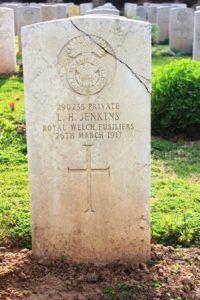
Evan William Jerman, Private, 38412, Welsh Regiment. Evan was born at Llanidloes in 1881, the son of William and Mary Jerman. He left home as a young man to find work as a miner in the South Wales valleys and in 1908 married Mary Emma Luke. Mary was from Camborne, Cornwall, and after the birth of the couple’s first child in Pontypridd in 1909, the couple moved to Penponds, Camborne, where Evan worked as a foundry labourer. He enlisted at Cambourne into the army soon after the outbreak of war and was drafted to France early in 1916, joining the 2nd Battalion, Welsh Regiment. The battalion was still in the Loos sector when Evan joined its ranks and was attached to 3 Brigade, 1st Division. During July 1916 the Division moved south, to join the great Somme offensive, and the 2nd Welsh reached Albert by 11 July, taking up billets in the town. On the morning of 15 July, the 2nd Welsh received orders to proceed via the recently captured Mametz Wood to the new front line, facing Bazentin Ridge, and took over positions near Bazentin-le-Petit Wood. On the following morning the battalion took part in its first assault on the Somme, but came under intense machine-gun fire, forcing the battalion to withdraw. On 19 July, after a torrid spell in the line, the 2nd Welsh was relieved and moved into reserve for a rest. Evan had been killed in action here on 18 July 1916, just a day before the 2nd Welsh was relieved. The 34-year-old has no known grave and is commemorated on the Thiepval Memorial, France. Evan is not commemorated on the Llanidloes war memorial.
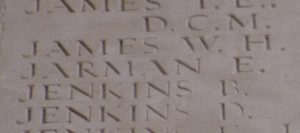
John Edward Jerman, Private, 203015, Royal Welsh Fusiliers. John was the son of Thomas and Annie Jerman, of Elephant Inn, Llanidloes. He worked for his parents prior to the war and was a serving Territorial, having enlisted into the Montgomeryshire Yeomanry at Llanidloes on 11 March 1912. John attended every summer TA camp in the years prior to the war. On 5 August 1914 the Montgomeryshire Yeomanry was mobilised at Welshpool, as part of the South Wales Mounted Brigade, before moving via Hereford to Thetford, to join the 1st Mounted Division. On 4 March 1916 the 1st Mounted Division sailed for Egypt to join the EEF, however John remained in Norfolk for a while, before being transferred to the 4th Battalion, Royal Welsh Fusiliers and embarking at Southampton for France on 17 December 1916. On the following day he disembarked and joined the 6th Infantry Base Depot at Rouen. He became ill soon after arriving in France and was hospitalised for a while, so it was not until 7 April 1917 that John was posted to the 1/4th Battalion, Royal Welsh Fusiliers. The battalion was by then the Pioneer Battalion to the 47th (2nd London) Division, and was at the Pioneer Camp, some 2,000 yards south of Vlamertinghe, in the Ypres Salient. The 4th RWF was working in the Railway Dugouts and Hill 60 sectors, constructing and maintaining trench tramways and light railways, as well as carrying out a host of other vital pioneer work. The Division took part in the Battle of Messines Ridge in June 1917, then later that year moved south in September to take part in the Battle of Cambrai. John returned home for two weeks leave in November 1917, re-joining the battalion at Senlis, where it was enjoying a brief rest period. On 2 January 1918 the battalion moved back into the front-line area near Equancourt and began work on the defences north-west of Gouzeaucourt. This work continued over the coming weeks, interspersed with rest periods behind the lines. By 20 March the 4th RWF was billeted at Lechelles, and at dawn the following morning, 21 March 1918, the men were awoken by the terrible sound of thousands of German artillery pieces firing all along the front. Soon afterwards a section of the line, running south from Croisilles to La Fère, was hit by German stormtroopers, elite highly trained shock-troops, who broke through the thinly held Allied front line. The 4th RWF was ordered forwards to take over defensive positions in Metz and on the following day came under attack. John was wounded near Metz on 22 March and was taken to the 3rd Casualty Clearing Station at Dernancourt where he died of his wounds on 25 March 1918. The 22-year-old is buried in Dernancourt Communal Cemetery Extension, France.
Bertram Jones, Private. Bertram cannot presently be identified.
Charles Evan Jones, Mechanic, 187141, Royal Air Force. Charles was born at Llanidloes in 1880, the son of Evan and Alice Jones. By 1901 he had left home and was living near Builth Wells, where he had found work as a Railway Porter. Charles married Jennie Nash at Pwllheli in 1906 and the couple moved to 38, Tower Street, Treforest, Pontypridd, where Charles worked as a colliery labourer. Charles enlisted into the Royal Flying Corps and served throughout the war as a Mechanic, until being discharged after the Armistice. He returned home to Treforest where he died of chronic nephritis on 15 May 1922, aged 42. Charles died too late for commemoration by the CWGC. He is not commemorated on the Llanidloes war memorial.
Edward Jones, Private, 290781, Royal Welsh Fusiliers. Edward was born in Caersws in 1886, the son of Evan and Eliza Jones. The family moved to 2, Severn Port, Llanidloes at some time after the turn of the century. Edward appears to have been somewhat of a character. He worked as a Hawker prior to enlisting at Llanidloes into the 7th Battalion, Royal Welsh Fusiliers on 20 October 1914, stating on his attestation form that he had previously served for two years with the 5th RWF and that he had been imprisoned for drunkenness and poaching. Within a month of enlisting, Edward was awarded 14 days detention for being absent without leave, then on 15 June 1915 was awarded 8 days detention for being absent off defaulter’s parade. He did not embark for Gallipoli with the battalion but was posted to the 2/7th Battalion, Royal Welsh Fusiliers at Bedford, where he again went absent without leave which resulted in another 10 days detention. He was then posted to the 3/7th RWF at Park Hall, Oswestry, where he was deprived of two days pay for irregular conduct. On 26 February 1916 he embarked for Egypt, joining the 1/7th Battalion, Royal Welsh Fusiliers, which was attached to 158 Brigade, 53rd (Welsh) Division. On 28 May 1916 he was deprived of 28 days pay for being drunk. On 26 March 1917 he fought during the disastrous First Battle of Gaza, and three days later was found drunk again and was fined 5 shillings. Edward fought during the Second and Third Battles of Gaza, and in the subsequent capture of Jerusalem, before the EEF took part in the continued drive north into Syria, then on 6 August 1918 was awarded 10 days Field Punishment No 2. Edward survived the war, but after the Armistice, when the 53rd (Welsh) Division had returned to Alexandria, he became ill and died of pneumonia on 15 December 1918. The 32-year-old is buried in Alexandria (Hadra) War Memorial Cemetery, Egypt. Edward is not commemorated on the Llanidloes war memorial.
Edward Stephen Jones, Private, 267789, Royal Welsh Fusiliers. Edward was the son of Edward and Mary Ann Jones, of Glanbidno Isaf, Llangurig. He worked as a farm labourer at Llangurig prior to enlisting into the 6th Battalion, Royal Welsh Fusiliers at Welshpool on 16 February 1916, and was initially placed on the Army Reserve. Edward was mobilised on 2 May 1916, attesting at Wrexham, before being posted to Park Hall Camp, Oswestry for training. Edward was originally placed in Category II, as fit for home service, as he had a history of rheumatic fever, but due to the need for recruits at the front, he embarked for France at Southampton on 10 June 1917, disembarking at Rouen the following day before entraining for Abbeville. On 18 September 1917, Edward was posted to the 4th Battalion, Royal Welsh Fusiliers, which was by that time in a rest camp at Eecke, following a long spell at Ypres, and was the Pioneer Battalion to the 47th (2nd London) Division. At the end of the month the Division moved south to positions some 2,000 yards north of Arras, and the 4th RWF began work on a trench 1,200 yards from Farbus and also on road repairs along the Roclincourt to Bailleul Road. The Division then took part in the Battle of Cambrai. During March 1918 the Division was situated near St. Quentin, and faced the German Spring Offensive here on 21 March, fighting an epic rear-guard action towards Senlis over the coming days. On 21 August 1918 the British attacked on the Somme, and the Division took part in the great offensive, from the area of Morlancourt, and over the coming weeks helped drive the Germans back towards the mighty Hindenburg Line, which was broken on 29 September, opening the door for the Allies. Edward had survived the war, but was taken ill after the Armistice and died of influenza at the 5th General Hospital, Boulogne on 1 December 1918. The 26-year-old is buried in Terlincthun British Cemetery, Wimille, France.
Edward Thomas Jones, Private, 472489, Canadian Infantry. Edward was born at Llanidloes on 3 September 1880, the son of Evan Jones and Margaret Jones (nee Davies). Edward married Isabel Jennie Davis at Newbury, Berkshire in 1908 and soon afterwards the couple emigrated to Canada, setting up home at Gladstone, Manitoba before settling at Canora, Saskatchewan, where they ran a general store, and Edward became a Civil Servant. Edward enlisted into the Canadian Infantry at Humboldt on 4 October 1915 and was posted to the 65th Overseas Battalion. Edward was posted to the Canadian Depot at Saskatoon, Saskatchewan soon afterwards, to begin his training. Edward had been on piquet duty on the night of 9 April 1916 when he was found lying dead at his post. A subsequent inquest found that he died from congestion of the lungs and was suffering from a medical condition that he had not disclosed when he enlisted. The 35-year-old was buried with full military honours in Greenwood Cemetery, Pelly, Canada. His unit embarked for Britain less than two months later.
Glyn Hilton Jones, Private, 12026, Machine Gun Corps. Glyn was born at High Street, Llanidloes in 1896, the son of Evan and Alice Jones and was baptised there on 20 December 1896. The family had moved to West End, Caersws by 1905. Glyn enlisted into the army at Newtown and was posted to the South Wales Borderers. Glyn must have trained as a specialist machine-gunner as upon being drafted to France he was posted to the Machine Gun Corps. Sadly there is no record of which unit he was posted to, but Glyn was wounded at Albert early in 1917 and was evacuated back to England, and taken to one of the Broadstairs Hospital in Thanet, Kent for treatment. He died there as a result of his wounds on 13 May 1917. The remains of the 20-year-old were conveyed home and he was buried in St. Gwynog’s Churchyard, Llanwnog. Glyn is not commemorated on the Llanidloes war memorial.
Harry Harold Jones, Private, 70419, Berkshire Yeomanry. Harry was born at the Old Hall, Llanidloes in 1888, the son of Hugh and Teresa Jones, and was baptised at Llanidloes on 20 October. His father was a Master at Llanidloes County School, and the family left the town for Pewsey, Wiltshire by 1898 after he gained another position as Headmaster there. Harry himself became a teacher prior to the war and worked under his father at Pewsey. He enlisted into the Berkshire Yeomanry soon after the outbreak of war and was posted to their 1/1st Battalion. The battalion mobilised at Reading attached to the 2nd South Midland Mounted Brigade, joining the 2nd Mounted Division at Churn. In November 1914 the Division moved to the Fakenham area, then on 21 April 1915 Harry embarked with the Berkshire Yeomanry for Egypt. On 18 August 1915 the battalion landed at Suvla Bay, Gallipoli, where it was dismounted and served as infantry. After surviving the terrible winter on the Peninsula, the Berkshire Yeomanry was evacuated in December 1915 and returned to Egypt, where the 2nd Mounted Division was broken up and its brigades became independent. Harry had been evacuated home sick towards the end of the Gallipoli campaign and married Lily Ada May Bick at Swindon on 16 March 1916, whilst on home leave. He returned to Egypt soon afterwards, re-joining the Berkshire Yeomanry, which by then was attached to the Imperial Mounted Division in Palestine. Harry was killed in action soon afterwards, on 24 August 1917. The 29-year-old has no known grave and is commemorated on the Jerusalem Memorial, Israel. Harry is not commemorated on the Llanidloes war memorial.
John Edwin Bernard Jones, Lance Corporal, 22051, Welsh Regiment. John was the son of Edwin and Eleanor Jane Jones, of 2, Glandwr Villas, Llanidloes. He had left Llanidloes just prior to the war to find work in the South Wales Valleys, but following the outbreak of war, enlisted into the 13th (Rhondda) Battalion, Welsh Regiment. The battalion had been raised at Cardiff from 23 October 1914, made up mainly of ex-miners, moving to Rhyl to join 129 Brigade, 43rd (Welsh) Division and trained in North Wales before moving to Winchester in the summer of 1915, where the formation became renumbered 114 Brigade, 38th (Welsh) Division. The Division moved to France on 2 December 1915 and moved to the Nursery Sector near Fleurbaix for trench initiation alongside the Guards Division. The Division then held a sector of the line near Cuinchy before marching south to the Somme sector in June 1916 to take part in the assault on Mametz Wood. The first attack on the wood was launched on a two-battalion front on 7 July, but failed, and the Divisional Commander, Sir Ivor Philipps, was replaced before the Division attacked again on a two Brigade front on 10 July 1916. John was killed in action at some time during the day. His body was found within the wood by members of the 113 Labour Company on 15 July 1916, whilst the wood was being cleared, and he was identified by his identity disc before being buried in Dantzig Alley British Cemetery, Mametz, France.
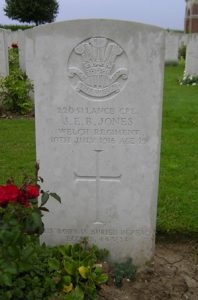
John Frederick Jones, Private, 290081, Royal Welsh Fusiliers. John was the son of Thomas and Jane Jones, of 39, Smithfield Street, Llanidloes. He was a long serving Territorial, having enlisted into the 7th Battalion, Royal Welsh Fusiliers at Llanidloes on 1 February 1912 and attended every annual TA summer camp over the coming years. John worked as a Wool Sorter prior to the war. The 7th Battalion, Royal Welsh Fusiliers mobilised for war at Newtown in August 1914, as part of North Wales Brigade, Welsh Division and moved to Conway until the end of the month, before moving to Northampton. In December the Division moved to Cambridge and then in May 1915 to Bedford, where the Division was numbered and the formation became 158 Brigade, 53rd (Welsh) Division. On 19 July 1915 the entire Division sailed from Devonport for Imbros and on 9 August 1915 landed at Suvla Bay. The infantry moved off the beaches across the Salt Lake, under shellfire, into the scrub covered Chocolate Hill, but due to a lack of maps and no knowledge of the terrain, many of the units became disorientated, and the situation became chaotic. After the fighting died down, the winter rolled in, and the men first had to endure torrential downpours, which flooded the trenches, before the snow hit, and many men began falling ill in the terrible conditions. The Division was eventually evacuated from Gallipoli in December 1915, moving to Egypt to join the EEF, and helped guard the Suez Canal before taking part in operations to drive the Turks out of the Sinai. The EEF then turned its attention onto driving the Turks out of Palestine, and on 26 March 1917 launched its first offensive against the coastal city of Gaza, which guarded the road to Jerusalem. Initial gains during the day were lost when the assaulting divisions lost touch with each other and communication broke down when a thick fog cloaked the battlefield. John was posted as missing, believed killed in action during the fighting that day. The 23-year-old has no known grave and is commemorated on the Jerusalem Memorial, Israel.
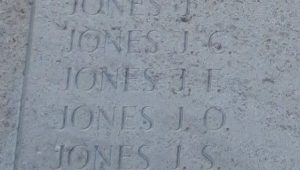
John Richard Jones, Lance Corporal, 290177, Royal Welsh Fusiliers. John was the son of Maurice and Elizabeth Jones, of Nantyrhebog Mills, Llanidloes. He worked as a Mason prior to the war and had enlisted into the 7th Battalion, Royal Welsh Fusiliers (Territorials) at Llanidloes on 16 February 1914. The battalion was a Territorial unit, which mobilised for war at Newtown in August 1914, as part of North Wales Brigade, Welsh Division and moved to Conway until the end of the month, before moving to Northampton. In December the Division moved to Cambridge and then in May 1915 to Bedford, where the Division was numbered and the formation became 158 Brigade, 53rd (Welsh) Division. On 19 July 1915 the entire Division sailed from Devonport for Imbros and on 9 August 1915 landed at Suvla Bay. The infantry moved off the beaches across the Salt Lake, under shellfire, into the scrub covered Chocolate Hill, but due to a lack of maps and no knowledge of the terrain, many of the units became disorientated, and the situation became chaotic. After the fighting died down, the winter rolled in, and the men first had to endure torrential downpours, which flooded the trenches, before the snow hit, and many men began falling ill in the terrible conditions. …The Division was eventually evacuated from Gallipoli in December 1915, moving to Egypt to join the EEF, and helped guard the Suez Canal before taking part in operations to drive the Turks out of the Sinai. The EEF then turned its attention onto driving the Turks out of Palestine, and on 26 March 1917 launched its first offensive against the coastal city of Gaza, which guarded the road to Jerusalem. Initial gains during the day were lost when the assaulting divisions lost touch with each other and communication broke down when a thick fog cloaked the battlefield. A second attempt to force Gaza was launched on 17 April, which also failed, and the EEF suffered a change in leadership, with Sir Edmund Allenby assuming command, before being re-organised, and a third offensive was launched against a wider front from Beersheba to Gaza on 31 October 1917. This time the Turkish defences were breached, and the road to Jerusalem now lay open and the EEF began to advance north. On 6 November 1917, 158 Brigade launched an attack on the Khuweilfeh Heights. John was killed in action during the attack that day. The 21-year-old is buried in Beersheba War Cemetery, Israel.
Richard Ernest Jones, Corporal, 4071, Royal Welsh Fusiliers. Richard was the son of Thomas and Susannah Jones, of 23, Hafren Terrace, Llanidloes. He enlisted into the 3/7th Battalion, Royal Welsh Fusiliers at Llanidloes on 27 November 1915, and was posted to Park Hall Camp, Oswestry for training. Richard took ill over the coming months, and was discharged from the army as medically unfit on 14 July 1916 after having been diagnosed as suffering from chronic epididymitis. Richard returned home to Llanidloes but his health deteriorated over the coming years and he died of phthisis on 5 March 1920. The 24-year-old was buried in Dolhafren Cemetery, Llanidloes. His death was adjudged to have been caused to sickness contracted through his military service, so Richard is an official war casualty. He is not commemorated on the Llanidloes war memorial.
Robert Jones, Private, 54795, Royal Welsh Fusiliers. Robert was the son of Robert and Elizabeth Jones, of Compton House, Llanidloes. He married Mary Ann Pryce in Llanidloes in 1914 and the couple lived at 4, Wellington Terrace, Llanidloes, where their only child Elizabeth was born in 1916. Robert enlisted at Llanidloes into the 3/7th Battalion, Royal Welsh Fusiliers and was posted to Park Hall Camp, Oswestry for training. He was drafted to France in the winter of 1916-17, and was posted to the 15th Battalion, Royal Welsh Fusiliers, which was at Ypres attached to 113 Brigade, 38th (Welsh) Division. The Division had moved to Ypres in September 1916, following heavy losses at Mametz Wood in July that year, and took over a section of the front at Hébuterne before moving to the Ypres Salient, and taking over the Canal Bank sector at Boesinghe. The infantry battalions of the Division then began carrying out the normal pattern of rotation in the trenches, four days in the front, four in support and four in reserve, whilst also working on trench improvement, digging new trenches, and also carrying out regular patrols and trench raids. On 11 June 1917 the 15th RWF relieved the 13th Welsh in the front line on the Canal Bank, to begin a routine tour in the trenches. The battalion spent the coming days being almost constantly shelled by German artillery. Robert was killed in action by shellfire on 15 June 1917. The 25-year-old is buried in Bard Cottage Cemetery, Belgium in what amounts to a mass grave, containing the remains of three men killed by the same shell that day.
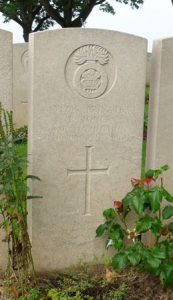
Robert Edward Jones, Private, 23247, Royal Welsh Fusiliers. Robert was the son of Daniel jones and Sarah Jane Jones, of 19, Victoria Avenue, Llanidloes. He married Ada Elsie Derry at Llanidloes on 24 September 1911. Robert worked as a Stationary Engine Man prior to enlisting into the 16th Battalion, Royal Welsh Fusiliers at Neath. The battalion was raised at Llandudno by the Welsh National Executive Committee from a cadre from the 13th Battalion, joining 128 Brigade, 43rd (Welsh) Division and trained in North Wales before moving to Winchester in the summer of 1915, where the formation became renumbered 113 Brigade, 38th (Welsh) Division. The Division moved to France on 2 December 1915 and moved to the Nursery Sector near Fleurbaix for trench initiation alongside the Guards Division. The Division then held a sector of the line near Cuinchy, a notorious sector where both sides lived in the constant fear of being undermined. On 17 February 1916 the 16th RWF left its reserve positions at Vielle Chapelle to take over a new line of trenches at Givenchy, between Hamilton Terrace and Fife Street, beginning a short tour in the line. The positions here consisted of raised parapets built of sandbags and other materials plundered from nearby buildings, interspersed with ’islands’ or strongpoints dotted around, as the ground was too wet for normal trenches. Robert was one of three men killed by German shellfire which hit the line here on 21 February 1916, just before the battalion was relieved. The 26-year-old is buried in Guards Cemetery, Windy Corner, Cuinchy, France.
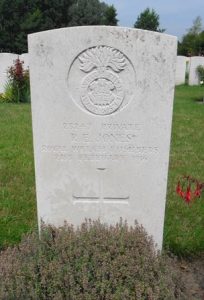
Robert William Horton Jones, Private, 53366, Manchester Regiment. Robert was born in Liverpool in 1882, the son of Thomas Jones and Adelaide Louisa Jones (nee Horton). He married Naomi Jones, of Llanidloes at Llanidloes in 1904, and the couple lived at 22, Asbridge Street, Toxteth, where Robert worked as a warehouseman. Robert enlisted into the King’s (Liverpool Regiment) following the outbreak of war, but was later transferred to the 2/9th Battalion, Manchester Regiment. The battalion formed at Ashton-under-Lyne in August 1914, joining 198 Brigade, 66th (East Lancs) Division and remained in Lancashire until about May 1915 when it moved to the Crowborough area. In March 1916 the Division moved to Colchester and on 4 March 1917 the 2/9th Manchester’s landed in France, entraining for the Merville area, where the Division concentrated, before taking over a section of the front line in the Cuinchy sector near the La Bassée Canal for trench initiation. The infantry battalions of the Division then began carrying out the usual routines of trench rotation, usually spending four days in the front line, four in reserve and four in support, interspersed with carrying out labouring duties and the occasional trench raid. On 25 June 1917 the Division was relieved and began to move to Dunkirk, prior to taking over a section of the front line on the Channel coast, in the Nieuport Sector. The Allies had planned for a possible assault along the Channel coast, as long as the Passchendaele offensive, which would be launched on 31 July, went as planned, but after the battle became bogged down in the Flanders mud, the 66th Division was among several British Divisions moved from the coast into the Ypres Salient, to bolster the offensive, being relieved on 26 September and reaching Vlamertinghe by 6 October, in time to take part in the Battle of Poelcapelle three days later, assaulting Passchendaele Ridge. The Division remained here over the coming weeks as the Third Battle of Ypres drew to a close, holding a section of line on the ridge. Robert was killed in action here on 1 December 1917, as his battalion was in the process of being relieved after a routine spell in the line. The 36-year-old has no known grave and is commemorated on the Tyne Cot Memorial, Belgium. His widow, Naomi, moved back home to 13, Brook Street, Llanidloes after his death. Robert is not commemorated on the Llanidloes war memorial.
Russell Hafrenydd Jones, Second Lieutenant, Royal Welsh Fusiliers. Russell was born on 11 April 1894, the son of Reverend Canon Edmund Osborne Jones and Ada Jones (nee Howells), of the Vicarage, Llanidloes. He was educated at King Edward’s School in Bath and worked for Lloyds Bank at St. James’ Street, London prior to the war. Russell enlisted into the Queen’s Westminster Rifles, London Regiment soon after the outbreak of war, but was commissioned as Second Lieutenant into the 7th Battalion, Royal Welsh Fusiliers. The battalion was a Territorial unit, which mobilised for war at Newtown in August 1914, as part of North Wales Brigade, Welsh Division and moved to Conway until the end of the month, before moving to Northampton. In December the Division moved to Cambridge and then in May 1915 to Bedford, where the Division was numbered and the formation became 158 Brigade, 53rd (Welsh) Division. On 19 July 1915 the entire Division sailed from Devonport for Imbros and on 9 August 1915 landed at Suvla Bay. The infantry moved off the beaches across the Salt Lake, under shellfire, into the scrub covered Chocolate Hill, but due to a lack of maps and no knowledge of the terrain, many of the units became disorientated, and the situation became chaotic. Russell was killed in action on the following day, 10 August 1915. The 21-year-old has no known grave and is commemorated on the Helles Memorial, Gallipoli. His brother Titho Glynne Jones served with the same battalion, and was killed at Gaza in 1917.
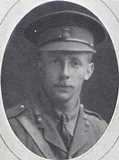
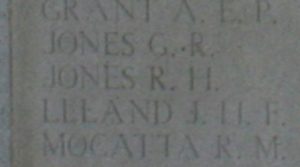
Simon Jones, Private, 203602, Royal Welsh Fusiliers. Simon was the son of David and Jane Jones, of Glan-y-nant, Glynbrochan. He worked as a Waggoner at Nantygeifr, Llangurig prior to enlisting into the 4th (Reserve) Battalion at Welshpool in February 1916 and was placed on the Army Reserve. Simon was mobilised on 20 January 1917, and attested at Wrexham, before being sent to Park Hall Camp, Oswestry for training. Simon had been in uniform for little over a week, before he took ill and was taken to Gobowen Military Hospital, where he died of pneumonia on 4 February 1917. The remains of the 21-year-old were brought home for burial in Dolhafren Cemetery, Llanidloes. Simon is not commemorated on the Llanidloes war memorial, but at nearby Llangurig.
Thomas Jones, Private, 291193, Royal Welsh Fusiliers. Thomas was the son of Hannah Jones, of 21, high Street, Llanidloes. His mother was widowed soon after Thomas’ birth. Thomas enlisted into the 3/7th Battalion, Royal Welsh Fusiliers at Llanidloes and was posted to Park Hall Camp, Oswestry for training. Early in 1916 he was drafted to Egypt, joining the 1/7th Battalion, Royal Welsh Fusiliers, which was attached to 158 Brigade, 53rd (Welsh) Division. The Division had been evacuated from Gallipoli in December 1915, moving to Egypt to join the EEF, and helped guard the Suez Canal before taking part in operations to drive the Turks out of the Sinai. The EEF then turned its attention onto driving the Turks out of Palestine, and on 26 March 1917 launched its first offensive against the coastal city of Gaza, which guarded the road to Jerusalem. Initial gains during the day were lost when the assaulting divisions lost touch with each other and communication broke down when a thick fog cloaked the battlefield. Thomas was posted as missing believed killed in action during the terrible fighting that day. The 21-year-old has no known grave and is commemorated on the Jerusalem Memorial, Israel.
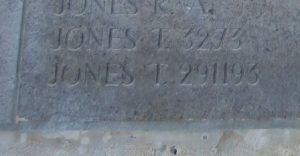
Thomas Jones, Private, 292714, Royal Welsh Fusiliers. Thomas was born in Llangurig in 1870, the son of Edward and Margaret Jones. The family later moved to Mount Street, Llanidloes. Thomas left home as a young man and enlisted into the 24th Foot (South Wales Borderers) at Newtown on 12 October 1887. He married Mary Burgess at Welshpool on 3 October 1893, after leaving the army, and the couple moved to 15, Bellvue Terrace, Aberfan, where Thomas had gained work as a collier. Following the outbreak of war, Thomas returned to his parents’ home at Mount Street, Llanidloes before enlisting into the 2/7th Battalion, Royal Welsh Fusiliers on 23 March 1915. With his previous experience as a soldier, he was immediately posted to the 1/7th Battalion, Royal Welsh Fusiliers. The battalion was a Territorial unit, which mobilised for war at Newtown in August 1914, as part of North Wales Brigade, Welsh Division and moved to Conway until the end of the month, before moving to Northampton. In December the Division moved to Cambridge and then in May 1915 to Bedford, where the Division was numbered and the formation became 158 Brigade, 53rd (Welsh) Division. On 19 July 1915 the entire Division sailed from Devonport for Imbros and on 9 August 1915 landed at Suvla Bay. The infantry moved off the beaches across the Salt Lake, under shellfire, into the scrub covered Chocolate Hill, but due to a lack of maps and no knowledge of the terrain, many of the units became disorientated, and the situation became chaotic. After the fighting died down, the winter rolled in, and the men first had to endure torrential downpours, which flooded the trenches, before the snow hit, and many men began falling ill in the terrible conditions. The Division was eventually evacuated from Gallipoli in December 1915, moving to Egypt to join the EEF, and helped guard the Suez Canal before taking part in operations to drive the Turks out of the Sinai. The EEF then turned its attention onto driving the Turks out of Palestine, and on 26 March 1917 launched its first offensive against the coastal city of Gaza, which guarded the road to Jerusalem. Initial gains during the day were lost when the assaulting divisions lost touch with each other and communication broke down when a thick fog cloaked the battlefield. A second attempt to force Gaza was launched on 17 April, which also failed, and the EEF suffered a change in leadership, with Sir Edmund Allenby assuming command, before being re-organised, and a third offensive was launched against a wider front from Beersheba to Gaza on 31 October 1917. This time the Turkish defences were breached, and the road to Jerusalem now lay open and the EEF began to advance north. On 6 November 1917, 158 Brigade launched an attack on the Khuweilfeh Heights. Thomas was wounded during the assault and was evacuated to a Casualty Clearing Station where he died of his wounds on 10 November 1917. The 50-year-old is buried in Beersheba War Cemetery, Israel. Thomas is not commemorated on the Llanidloes war memorial but is commemorated at Aberfan.
Thomas Henry Davies Jones, Corporal, 3095, Royal Welsh Fusiliers. Thomas was the son of Evan Jones and Mary Jane Jones (nee Davies), of Llanidloes. He married Caroline Mills in 1897 and the couple lived in 34, Smithfield Street, Llanidloes. Thomas worked as a hairdresser prior to enlisting into the 2/7th Battalion, Royal Welsh Fusiliers at Llanidloes on 13 October 1914. The battalion had formed at Newtown from a surplus of personnel who had enlisted into the original 7th Battalion, Royal Welsh Fusiliers and was a second line Territorial Army unit. During April 1915 the battalion moved to Northampton to join 203 Brigade, 68th (2nd Welsh) Division, then in July 1915 moved to Bedford. Charles was promoted twice over the coming months, being appointed Lance Corporal on 16 September 1915 and Corporal on 12 May 1916. During November 1916 the battalion moved to Southwold, on coastal defence duties, but by then Thomas had started to have problems with his health and was in hospital in Bedford. He was found to have contracted pulmonary tuberculosis before being discharged from the army as medically unfit on 24 November 1916 and returned to Llanidloes. Thomas died of tuberculosis at home on 25 January 1918. The 41-year-old was buried in Dolhafren Cemetery, Llanidloes. His brother, Walter George Cotterill Jones, also fell.
Titho Glynne Jones, Lieutenant, Royal Welsh Fusiliers. Titho was born at Soham, Cambridgeshire in 1887, the son of Reverend Canon Edmund Osborne Jones and Ada Jones (nee Howells). The family had moved to Brecon by 1891, and by the following year were residing at the Vicarage, Llanidloes. Titho was educated at Christ’s College, Brecon, where he played for the Rugby XV and also played football for Brecon Town. Upon graduating from Brecon, he became an articled clerk, to Mr. W. P. Jones, solicitor of Aberystwyth in 1906, passing his final law examination in 1910. Prior to the war Titho had emigrated to Canada and set up business in British Columbia, but following the declaration of war returned to Britain aboard the SS Lusitania and enlisted into the Queen Victoria’s Rifles, London Regiment, serving in France with the battalion from 4 November 1914. On 20 March 1915 Titho was commissioned as Second Lieutenant into the 2/7th Battalion, Royal Welsh Fusiliers, before being posted to the 1/7th Battalion, Royal Welsh Fusiliers. The battalion was a Territorial unit, which mobilised for war at Newtown in August 1914, as part of North Wales Brigade, Welsh Division and moved to Conway until the end of the month, before moving to Northampton. In December the Division moved to Cambridge and then in May 1915 to Bedford, where the Division was numbered and the formation became 158 Brigade, 53rd (Welsh) Division. On 19 July 1915 the entire Division sailed from Devonport for Imbros and on 9 August 1915 landed at Suvla Bay. The infantry moved off the beaches across the Salt Lake, under shellfire, into the scrub covered Chocolate Hill, but due to a lack of maps and no knowledge of the terrain, many of the units became disorientated, and the situation became chaotic. After the fighting died down, the winter rolled in, and the men first had to endure torrential downpours, which flooded the trenches, before the snow hit, and many men began falling ill in the terrible conditions. The Division was eventually evacuated from Gallipoli in December 1915, moving to Egypt to join the EEF, and helped guard the Suez Canal before taking part in operations to drive the Turks out of the Sinai. The EEF then turned its attention onto driving the Turks out of Palestine, and on 26 March 1917 launched its first offensive against the coastal city of Gaza, which guarded the road to Jerusalem. Initial gains during the day were lost when the assaulting divisions lost touch with each other and communication broke down when a thick fog cloaked the battlefield. A second attempt to force Gaza was launched on 17 April, which also failed. Titho was killed on the day after the battle ground to a halt, on 20 April 1917. The 30-year-old is buried in Gaza War Cemetery, Israel. His brother Russell Hafrenydd Jones served with the same battalion and was killed at Gallipoli in 1915.
Walter George Cotterill Jones, Second Lieutenant, Royal Flying Corps. Walter was born at Caersws on 8 February 1879, the son of Evan Jones and Mary J. Jones (née Davies). By 1881 his father had died and the family had moved in with Mary’s parents at the Coach and Horses, Llanidloes. Walter had already served for a while with the Montgomeryshire Yeomanry prior to enlisting into the Northamptonshire Yeomanry in London on 20 March 1901 and just over a week later he embarked for South Africa, to fight with the 21st Battalion, Imperial Yeomanry during the Anglo-Boer War. He returned to Britain after 15 months service in South Africa and after being discharged in Aldershot on 16 August 1902, returned to his civilian occupation as a Clerk. By 1911 he was residing at Carlisle Terrace, St. Ives, where he was employed as a representative for a manufacturer of cake manure. Walter re-enlisted into the Northamptonshire Yeomanry soon after the outbreak of war, and served in France with the regiment, gaining the rank of Sergeant by 1916. He returned to Britain where he learned to fly at the Hall School at Hendon, gaining his pilots certificate on 21 October 1916 aboard a Hall Biplane. Walter was then commissioned as Second Lieutenant into the Royal Flying Corps on 10 June 1917 and was among the original members of 105 Squadron, Royal Flying Corps, following its formation at RAF Waddington on 23 September 1917. The Squadron then moved to RAF Andover in Hampshire to train as a bomber squadron and was equipped with a variety of aircraft. On Sunday 17 March 1918 Walter was flying a BE12 biplane from Andover over Ramridge Farm, Weyhill. Whilst flying at a low altitude, he lost control of the aeroplane which crashed into the ground and burst into flames, killing him instantly. The remains of the 39-year-old were buried in St. Ives Public Cemetery, Cambridgeshire. His brother, Thomas Henry Davies Jones, also died as a result of the war.
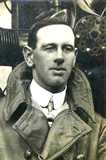
William Owen Lewis, Private, 34536, The Loyal North Lancashire Regiment. William was born in 1882, the son of John and Elizabeth Lewis, of Llanidloes and was baptised there on 6 August that year. The family moved to Brecon by 1891 and William married Annie Hargest at Bwlch in 1905. William enlisted into the army at Brecon and was drafted to France in the Spring of 1917, where he was posted to the 9th Battalion, The Loyal North Lancashire Regiment. The battalion was attached to 74 Brigade, 25th Division in the Ploegsteert sector, remaining here over the coming months leading up the Battle of Messines in June 1917. After fighting at Messines, the Division moved north, and fought at Pilckem, before moving south again, taking up positions around Bullecourt in reserve. Here the Division was used to reinforce the badly depleted British units that were hit in the area by the German Spring Offensive from 21 March 1918. The Division moved north to Flanders on the night of 30 March, where it took up positions at Ploegsteert again and over the coming days rested and refitted. Unfortunately, on 9 April the Germans launched an offensive on the Lys, and the Division was caught up in the terrible fighting here over the coming days. The battered Division withdrew to Abeele on 17 April, but on 25 April was ordered back into the line, and took part in the Second Battle of Kemmel. On 9 May the Division moved to Fismes, 20 miles south-east of Soissons in the Champagne, to give it a chance to rest and rebuild again. However, on 26 May the Division took up positions south of the Aisne, to guard against a predicted German Offensive and at dawn on the following day, 27 May 1918 the attack hit them, and during the coming days the Division was virtually annihilated. William had been taken prisoner during the fighting in the Champagne, and was taken to a Prisoner of War camp in Germany, where he died of influenza on 14 October 1918. The 37-year-old is buried in Niederzwehren Cemetery, Kassel, Germany. William is not commemorated on the Llanidloes war memorial, but is commemorated on the war memorial at Bwlch, Breconshire.
Edward Adolphus Matthews, Private, 91415, Royal Welsh Fusiliers. Edward was the son of Ezekiel Matthews and Margaret Ann Matthews (nee Clayton), of 9, Kington Cottages, Llanidloes. He enlisted at Wrexham into the army and in the Spring of 1918 was drafted to France, joining the 25th Battalion, Royal Welsh Fusiliers, which was attached to 231 Brigade, 74th (Yeomanry) Division. The Division had been transferred to France from Palestine as a result of the heavy losses suffered by the British in France, following the launching of the three German Spring offensives from 21 March 1918 and landed in Marseilles on 7 May 1918. The Division underwent a system of training, to prepare it for the vastly different conditions on the Western Front, before taking over a section of the front in the St. Floris Sector. In September the Division moved south to the Somme sector, to join the great offensive, and on 18 September took part in an assault on positions near Lempire and Ronssoy, which formed part of the outer defensive line for the Hindenburg Line. After suffering heavy casualties, especially around Orchard Post and Gillemont Farm, the Division then attacked the Quadrilateral defences, suffering heavily again. Edward had been killed in action during the assault on the Quadrilateral on 21 September 1918. The 18-year-old has no known grave and is commemorated on the Vis-en-Artois Memorial, Haucourt, France.
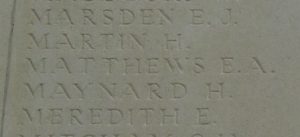
Arthur Price Mills, Sergeant, 5596, Royal Welsh Fusiliers. Arthur was born in Llanidloes in 1877, the son of John Henry Mills and Annie Mills (nee Jones). He left home as a young man, enlisting into the Royal Welsh Fusiliers at Dowlais in 1893. Arthur married his wife Maria Mills at Plymouth in 1905 and by 1911 was residing at 12, Victoria Terrace, Llanberis with Maria and their only child, Arthur Edward Mills, where he was a serving Sergeant with the Royal Welsh Fusiliers Territorials. The family then moved to Wrexham in 1912, and Arthur was based at the Barracks there. Following the outbreak of war, he was still serving with the regiment at Wrexham. He spent the early years of the war on home service, using his vast experience to help train some of the many thousands of raw recruits needed for the army, but embarked to France to join the 16th Battalion, Royal Welsh Fusiliers in the winter of 1916-17. The battalion was attached to 113 Brigade, 38th (Welsh) Division which was holding the Canal Bank sector north of Ypres, at Boesinghe, which it had held since September 1916 after being evacuated from the Somme and its famous assault on Mametz Wood. The Division remained here over the coming months, its infantry battalions rotating between duties in the front line, usually four days in the front, four in reserve and four in support, as well as carrying out pioneer duties, digging and improving trenches, in preparation for the forthcoming Third Battle of Ypres. On the morning of 31 July 1917, the Division launched an assault upon the Pilckem Ridge, storming its objectives, capturing Iron Cross and reaching the Steenbeek by the end of the day. Arthur was killed in action during the days fighting. The 40-year-old is buried in Dragoon Camp Cemetery, Belgium.
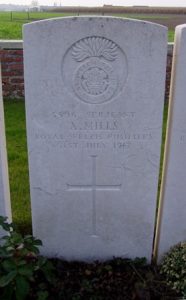
John Bertram Mills, Private, 2907, Royal Welsh Fusiliers. John was the son of Mills and Ellen Mills, of 10, Penygraig Street, Llanidloes. He worked as a Labourer prior to the war. John enlisted into the 7th Battalion, Royal Welsh Fusiliers at Llanidloes. The battalion was a Territorial unit, which mobilised for war at Newtown in August 1914, as part of North Wales Brigade, Welsh Division and moved to Conway until the end of the month, before moving to Northampton. In December the Division moved to Cambridge and then in May 1915 to Bedford, where the Division was numbered and the formation became 158 Brigade, 53rd (Welsh) Division. On 19 July 1915 the entire Division sailed from Devonport for Imbros and on 9 August 1915 landed at Suvla Bay. The infantry moved off the beaches across the Salt Lake, under shellfire, into the scrub covered Chocolate Hill, but due to a lack of maps and no knowledge of the terrain, many of the units became disorientated, and the situation became chaotic. John was wounded during the advance which followed the landings and died of his wounds on 11 August 1915. The 29-year-old is buried in Lancashire Landing Cemetery, Gallipoli.
William Wilson Morgan, Private, 7751, Australian Infantry. William was the son of Richard and Charlotte Alice Morgan, of Bryndu Farm, Llanidloes. He was educated at the Llanidloes County School before becoming a Civil Servant and emigrated to Australia prior to the war, where he became a farmer. William enlisted into the Australian Infantry at Perth on 19 February 1917 and was posted to the 26th Reinforcements for the 11th Battalion, Australian Infantry. On 29 June 1917 the 26th Reinforcements embarked at Fremantle aboard HMAT Borda and sailing via the Suez Canal, reached Plymouth by 25 August. The men then moved to the Australian camp at Sutton Veny to continue their training. On 27 December 1917 William embarked for France at Southampton and disembarked at Le Havre the following day. On 2 January 1918 he was taken on strength by the 11th Battalion, Australian Infantry, which was attached to the 3rd Australian Brigade, 1st Australian Division. The battalion had taken part in every major action fought by the Australians during the war: at Gallipoli in 1915, then on the Somme at Pozieres and Mouquet Farm in 1916. In 1917 the battalion fought at Bullecourt and then at the Battle of Passchendaele. William was among 290 men who joined the 11th Battalion at Gable Farm, near Messines. The battalion was enjoying a rare period of relative peace and was supplying working parties for the 1st Australian Division. On 9 January the 11th Battalion moved into the front line in the Messines sector, to begin a routine tour, Williams first taste of life in the trenches. During the early morning of 13 January 1918, William was in No 5 Post, located at grid reference O35d31, when it was hit by a German minenwerfer shell, killing William and three other men instantly and wounding five others. The 33-year-old has no known grave and is commemorated on the Ypres (Menin Gate) Memorial, Belgium.
Llewellyn Ivor Owen, Private, 41063, Labour Corps. Llewellyn was the son of John and Jane Owen, of Llanidloes. He worked as a Draper in the town prior to the war and had a premise in China Street. Llewellyn enlisted into the 13th Battalion, Royal Welsh Surrey Regiment at Northampton on 12 February 1917 and was medically downgraded, being deemed as unfit for infantry service, before being posted to the 121st Labour Company, Labour Corps. On 6 March 1917 Llewellyn was posted out to France with the Company, but within months his health began to fail and on 13 October 1917 he was posted back to Britain and sent to Manor Hill Red Cross Hospital at Birkenhead. Llewellyn was diagnosed as suffering from High Myopia and was discharged from the army on 17 December 1917. He returned home to Llanidloes and began a relationship with Sarah Ellen Whitehead, of Newtown. The couple married in Leicester in 1919, where Llewellyn had started up a leather supply business. Llewellyn’s health continued to deteriorate and he died at Leicester on Christmas Day, 25 December 1919, aged 32. Llewellyn is not commemorated by the CWGC, so nothing further is known of him.
Thomas Harcourt Owen, Private, 58504, Lancashire Fusiliers. Thomas was the son of David and Elizabeth Owen, of Goleubryn, Llanidloes. He enlisted into the Training Reserve and probably trained at Kinmel Park before being drafted to France in the Spring of 1918, where he was posted to the 2/5th Battalion, Lancashire Fusiliers. The battalion was attached to 164 Brigade, 55th (West Lancs) Division and had suffered terrible losses during the Battle of Cambrai the previous year, when it had faced the enemy counter attack on 30 November 1917, and was decimated. The remnants of the Division were withdrawn from the area and sent to Bomy, near Fruges for intensive training and refitting. The Division relieved the 42nd (East Lancashire) Division in the front line at Givenchy and Festubert on 15 February, and faced numerous enemy raids in March as the Germans probed the lines in preparation for their forthcoming offensive. The first week of April was relatively quiet, as fighting raged to the south, following the opening of the first phase of the German offensive on 21 March, but on 9 April the Germans launched the second phase of their offensive along the Lys valley and the 55th Division became caught up in desperate fighting as the line was pushed back towards Éstaires and took part in the First Defence of Givenchy, the single most famous action that the Division fought. The Division then fought at the Battle of Hazebrouck, before the fighting calmed down and German attention was switched further south to the Champagne sector in May. The 55th Division remained in Flanders over the coming weeks and in June the 2/5th Lancashire Fusiliers moved to Vaudricourt Camp to rest and reorganise. The men enjoyed inter-company sports activities and regular baths, which were well deserved after the fighting they had seen during the preceding weeks. After this short break the men then spent the coming days training before taking over a section of front line near Annequin on 14 June 1918, to begin a routine tour in the trenches in the Givenchy Left sector. On the night of 19-20 June, the battalion sent out a raiding party, with the objectives of obtaining prisoners; killing as many of the enemy as possible; and to capture machine-guns. The raid was meticulously planned, with a preliminary trench mortar barrage to cover the raiding party as it advanced across No Mans Land, and for the party to enter the German lines at the junction of Grenadier Road, the O.B. Line and New Ross Trench. Thomas was one of the men chosen to join No 5 party, under Second Lieutenant Wake. The men started out well under the barrage but became subject to machine-gun and trench mortar fire before being forced to withdraw due to thick barbed wire. Thomas was the sole man killed during the raid, although a number were wounded. The 18-year-old is officially recorded as having been killed during the morning of 20 June 1918. He is buried in Houchin British Cemetery, France.
John Pryce, Private, 291321, Royal Welsh Fusiliers. John was the son of Walter and Margaret Pryce, of Cwmdu, Trefeglwys. He lived at 4, Van Lines, Llanidloes and worked as a Waggoner prior to the war. John enlisted into the 7th Battalion, Royal Welsh Fusiliers at Newtown on 8 December 1915, and was posted to the 3/7th Battalion, Royal Welsh Fusiliers at Park Hall, Oswestry for training. John embarked at Devonport on 3 July 1916, and disembarked in Alexandria on 17 July, before being posted to the 1/7th Battalion, Royal Welsh Fusiliers. The battalion was attached to 158 Brigade, 53rd (Welsh) Division, and had been evacuated from Gallipoli in December 1915, moving to Egypt to join the EEF, and helped guard the Suez Canal before taking part in operations to drive the Turks out of the Sinai. The EEF then turned its attention onto driving the Turks out of Palestine, and on 26 March 1917 launched its first offensive against the coastal city of Gaza, which guarded the road to Jerusalem. Initial gains during the day were lost when the assaulting divisions lost touch with each other and communication broke down when a thick fog cloaked the battlefield. John was killed in action during the terrible fighting that day. The 22-year-old has no known grave and is commemorated on the Jerusalem Memorial, Israel.
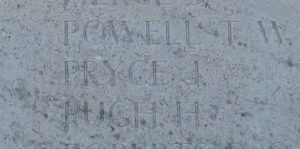
John Percival Pryce, Sergeant, 241348, Worcestershire Regiment. John was the son of Charles Edwin Pryce and Elizabeth Pryce (nee Lewis), of 3 Wellington Terrace, Llanidloes. He lived at Bank House Shop, Llanidloes prior to the war. John enlisted into the 1/8th Battalion, Worcestershire Regiment at Worcester. The battalion was a Territorial unit, attached to 144 Brigade, 48th Division and had fought on the Western Front from March 1915 before being despatched to the Italian front in November 1917. John had risen to the rank of Sergeant before being transferred to the 2nd Battalion, Worcestershire Regiment and he most likely transferred before the move of his original battalion to Italy. The 2nd Worcester’s had been in France since the outbreak of war, initially attached to 5 Brigade, 2nd Division, but on 20 December 1915 had transferred to the newly arrived 100 Brigade, 33rd Division. The Division saw its first major action during the Battle of the Somme, from July 1916 onwards. During the following year the Division saw heavy fighting at the Battle of the Scarpe and at Bullecourt, before heading to Ypres, and took part in the Battle of the Menin Road and at Polygon Wood. The Division wintered in Flanders and in April 1918 saw heavy fighting following the German Lys offensive of 9 April 1918, playing a part in the Defence of Neuve Eglise. The Division then took part in the First Battle of Kemmel, where the Division recaptured Ridge Wood. During the beginning of August, the 2nd Worcester’s were in the front line, where the battalions CO received orders to send out parties of men to form advanced posts. This work was carried out without delay, but on 7 August 1918 the Germans launched an artillery barrage upon these new posts, killing John and wounding three other men. The remains of the 28-year-old were recovered and he is buried in Hagle Dump Cemetery, Belgium. One of his brothers, Robert Edward Pryce, was awarded the Military Medal during the war.
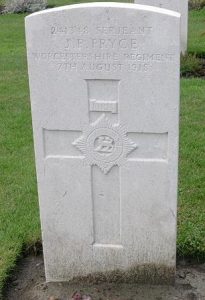
William Christopher Rees, Corporal, 160880, Royal Engineers. William was born in Sydney, New South Wales in 1894, the son of Evan and Anne Rees. His father was originally from Llanidloes but had emigrated to Australia in the 1880’s, where he had married Anne in 1890. William and a sister, Florence were then born in Sydney. By 1901 the family had returned to Britain and were residing at Bamburgh, where another child, Gwendoline, was born, then the family moved to London for a short while before moving back home, to 8, long Bridge Street, Llanidloes. William enlisted into the Royal Engineers soon after the outbreak of war and served on the Western Front. After the Armistice he became ill and on 13 November 1919 was medically discharged due to suffering from bronchial catarrh. William returned home to Llanidloes, but his health continued to deteriorate and he died of tuberculosis on 13 June 1922, aged 28. Little else is known of him as he is not commemorated by the CWGC. William is not commemorated on the Llanidloes war memorial.
Robert Roberts, Rifleman, S/9214, Rifle Brigade. Robert was born in Bethel Street, Llanidloes in 1878, the son of William and Elizabeth Roberts. The family had moved to South Wales looking for work by 1885 and moved to Glyntaff, Pontypridd after William had gained work at the Albion Colliery at Cilfynydd. Sadly, William was at work underground at the Colliery on 23 June 1894 when a massive explosion tore through the mine workings, killing 290 men and boys, leaving almost every family in Pontypridd in mourning. At least six men from Llanidloes died in the disaster. Despite the sad loss of their father, Robert and his three brothers worked underground as soon as they were old enough. Robert enlisted into the Rifle Brigade at Pontypridd soon after the outbreak of war, and on 16 June 1915 was drafted to France, joining the 2nd Battalion, Rifle Brigade in rest billets at La Gorgue three days later. The battalion had been rushed back from garrison duties in India following the outbreak of war and had been in France since November 1914 attached to 25 Brigade, 8th Division. The Division held the sector of the line near Bois Grenier throughout much of 1915, whilst preparing to launch a feint attack. Throughout September the battalions of the Division worked hard to prepare the trenches, with orders to attack a 1,200-yard section of the German front line between Corner Farm and the Bridoux Fort, with the objectives being to straighten and shorten our line and to assist the main attack by First Army at Loos. The 2nd Rifle Brigade was ordered to assault and capture Corner Farm itself. The men left their trenches at dawn on 25 September 1915 behind an artillery bombardment and, despite being held up for a while by barbed wire, successfully attained its objective. Robert had been killed in action during the attack that day. The 37-year-old has no known grave and is commemorated on the Ploegsteert Memorial, Belgium. Robert is not commemorated on the Llanidloes war memorial.
Frank Rogers, Company Sergeant Major, 105, Royal Welsh Fusiliers. Frank was the son of John and Sarah Rogers, of London House, Llanidloes. He worked as a shop assistant for his parents prior to the war. Frank enlisted at Llanidloes into the 7th Battalion, Royal Welsh Fusiliers. The battalion was a Territorial unit, which mobilised for war at Newtown in August 1914, as part of North Wales Brigade, Welsh Division and moved to Conway until the end of the month, before moving to Northampton. In December the Division moved to Cambridge and then in May 1915 to Bedford, where the Division was numbered and the formation became 158 Brigade, 53rd (Welsh) Division. On 19 July 1915 the entire Division sailed from Devonport for Imbros and on 9 August 1915 landed at Suvla Bay. The infantry moved off the beaches across the Salt Lake, under shellfire, into the scrub covered Chocolate Hill, but due to a lack of maps and no knowledge of the terrain, many of the units became disorientated, and the situation became chaotic. Frank had been killed in action during the advance of 10 August 1915. The 33-year-old has no known grave and is commemorated on the Helles Memorial, Gallipoli.
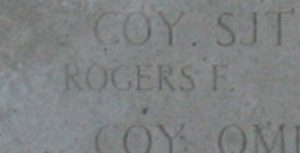
Alfred Albert Rowley, Company Sergeant Major, 5886, Royal Welsh Fusiliers. Alfred was the son of George and Mary Ann Rowley, of Wallington, Surrey. Alfred was a musician when he enlisted into the Royal Welsh Fusiliers at Warley on 2 December 1898, at the age of 15 years, 3 months, and was initially posted to Pembroke Dock. Over the following years he served in Hong Kong and India, before returning to Britain and was stationed in Cork by 2 October 1907. His next posting was to the RWF barracks in Wrexham on 8 August 1908 and whilst stationed there he married Ellen McCann at Wrexham on 31 July 1912. He then left the army and the couple then moved to 18, Foundry Terrace, Llanidloes where their two sons were born. Following the outbreak of war, Alfred re-enlisted at Wrexham and was initially posted to the 1/7th Battalion, Royal Welsh Fusiliers. On 7 July 1915 he was attached to the 1/7th Battalion, Lancashire Fusiliers, which was at Gallipoli attached to 12 Brigade, 42nd (East Lancs) Division. Alfred had joined the battalion on the Peninsula a month prior to the landings of the 53rd (Welsh) Division, to which his original unit, the 7th RWF was attached. The 7th Lancashire Fusiliers had a brief rest on the Island of Imbros from 8 to 13 July and upon its return to Gallipoli on 4 August it moved into the Redoubt Line. Three days later the battalion advanced to the front line at Krithia Road to take part in the Battle of Krithia Vineyard. The attack was meant to divert attention away from the main landings on 8-9 August, but was a disaster, with the 7th Lancashire Fusiliers alone losing over half its strength. Alfred was badly wounded in the abdomen during the attack on 7 August and died of his wounds the following day, 8 August 1915. The 32-year-old is buried in Lancashire Landing Cemetery, Gallipoli.
Albert Lewis Evans Willey, Private, 55565, Royal Welsh Fusiliers. Albert was born in Nantmel, Radnorshire in 1899, the son of Isaac Willey and Effie Elizabeth Willey (nee Evans). By 1907 the family had moved to 12, Cemetery Square, Llanidloes. Albert enlisted into the Royal Welsh Fusiliers at Llanidloes and after completing his training was drafted to France in the winter of 1916-17, joining C Company of the 10th Battalion, Royal Welsh Fusiliers, which was attached to 76 Brigade, 3rd Division. Albert joined the battalion on the Somme, in a rest camp at Bus, along with a large number of drafts, following the battalion’s suicidal assault on Serre on 13 November 1916, when almost 300 officers and men were killed. The battalion went back into the line at Serre soon afterwards and the Division held this line over the coming months before being relieved early in January. By 10 January the Division was situated around Halloy, resting and refitting and by the middle of February 1917 had taken over a new section of the front in the Arras sector, where the infantry battalions began the usual routine of trench rotation. On 6 April 1917 the 10th RWF marched out of reserve positions at Wanquetin in heavy rain and moved into cellars in the city of Arras before moving out of the city to its assembly positions during the evening of 8 April, preparatory for an assault the following morning. The assault was launched at 05.30 the following morning and the men of the 10th RWF attained their objectives before consolidating their gains. On the morning of 11 April, the battalion moved forwards again to Feuchy Chappelle and prepared to launch an assault on the strongly defended town of Guemappe. The attack was launched at dawn on 12 April 1917 but failed to reach Guemappe, being held up by heavy machine-gun fire and heavy artillery fire. Albert was badly wounded during the assault on Guemappe and died that same day. The 19-year-old is buried in Duisans British Cemetery, Étrun, France.
Edward Williams, Lance Corporal, 15884, Royal Welsh Fusiliers. Edward was born at Llanidloes in 1883, the son of Edward and Hannah Williams. He was baptised at Llanidloes on 4 March 1883. By 1891 the family had moved to 3, Crossways Street, Coedpenmaen, Pontypridd, after Edward’s father had found work as a coalminer at the Albion Colliery at Cilfynydd. Sadly, Edward’s father was at work underground at the Colliery on 23 June 1894 when a massive explosion tore through the mine workings, killing 290 men and boys, leaving almost every family in Pontypridd in mourning. At least six men from Llanidloes died in the disaster. Young Edward followed his father into the coal industry, becoming a coal hewer as soon as he was old enough. He enlisted into the 9th Battalion, Royal Welsh Fusiliers at Pontypridd soon after the outbreak of war. The battalion had formed at Wrexham in September 1914, before moving to Tidworth to join 58 Brigade, 19th (Western) Division. On 19 July 1915 Evan landed in France with the battalion, and the entire 19th Division then moved to the Nursery Sector at Calonne for trench initiation alongside the Dehra Dun Brigade. The infantry battalions of the division then began carrying out the usual routines of rotating in the trenches: four days in the front line; four in support; and four in reserve, interspersed with training regimes and carrying out working parties and trench raids. Just south, the British launched a great offensive around the town of Loos on 25 September 1915, and the 19th Division was ordered to attack from its positions at the same time, to attempt to draw enemy attention away from the main battle area. The assault was a disaster, and heavy casualties were suffered by the 19th Division for no gain. The Division wintered on the Somme and in February followed the German withdrawal to the Hindenburg Line. During the middle of March 1917, the Division was relieved from the line and began to move north, taking over positions in the Ypres Salient, and on 7 June took part in the assault on Messines Ridge, which was famously preceded by the blowing of a series of 19 huge underground mines. Edward was wounded at some time prior to this and upon his recovery was transferred to the 2nd Battalion, Royal Welsh Fusiliers. The battalion was attached to 19 Brigade, 33rd Division and was on the Flanders Coast during the summer of 1917, preparing for a possible offensive. Following the failure of the army to break out at Ypres, the Division was rushed to the city, before taking over positions facing Polygon Wood by 25 September, joining the Passchendaele offensive. Over the coming days the Division saw terrible fighting for the wood, before being relieved, and moved to the Messines Sector the following month. By 18 November the Division had moved back to Ypres and on 24 November the 2nd RWF relieved the Cameronian’s in the Left Sub Sector at Passchendaele to begin a routine tour in the trenches. Edward was killed here by artillery fire on 26 November 1917. The 35-year-old is buried in Tyne Cot Cemetery, Belgium. Edward is not commemorated on the Llanidloes war memorial.
Harry Williams, Private, 291010, Royal Welsh Fusiliers. Harry was born in Bethesda in 1878, the son of John and Ann Williams. By 1897 the family had moved to 7, Angel Yard, Llanidloes, where John was working as a Navvy. Harry was living at 7, Angel Yard when he enlisted into the 2/7th Battalion, Royal Welsh Fusiliers at Llanidloes on 13 March 1915 and joined the battalion at Northampton, where it was attached to 203 Brigade, 68th (2nd Welsh) Division. On 17 July 1915 Harry embarked at Devonport for the Mediterranean and disembarked at Alexandria on 1 August. Instead of being posted to the 1/7th Battalion, Royal Welsh Fusiliers at Gallipoli, he was initially attached to the 21st General Hospital at Alexandria for duty. He did not join the 7th RWF until after its evacuation, together with the rest of 158 Brigade, 53rd (Welsh) Division, from Gallipoli in December 1915. The Division then helped guard the Suez Canal before taking part in operations to drive the Turks out of the Sinai. The EEF then turned its attention onto driving the Turks out of Palestine, and on 26 March 1917 launched its first offensive against the coastal city of Gaza, which guarded the road to Jerusalem. Initial gains during the day were lost when the assaulting divisions lost touch with each other and communication broke down when a thick fog cloaked the battlefield. Harry was killed in action during the terrible fighting that day. The 37-year-old has no known grave and is commemorated on the Jerusalem Memorial, Israel. His youngest brother, Hugh, also fell during the war but neither man is commemorated on the Llanidloes war memorial.
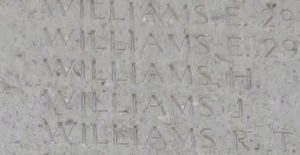
Hugh Granville Williams, Private, 25232, Royal Welsh Fusiliers. Hugh was born in 1897, the son of John and Ann Williams, of 7, Angel Yard, Llanidloes. The family moved to 2, Baltic Field, Blaenau Ffestiniog just prior to the war and Hugh enlisted there into the 17th Battalion, Royal Welsh Fusiliers on 16 March 1915. The battalion was raised at Llandudno, joining the 43rd (Welsh) Division and trained in North Wales before moving to Winchester in the summer of 1915, where the battalion joined the re-numbered 115 Brigade, 38th (Welsh) Division. The Division moved to France on 2 December 1915 and moved to the Nursery Sector near Fleurbaix for trench initiation alongside the Guards Division. The Division then held a sector of the line near Cuinchy before marching south to the Somme sector in June 1916 to take part in the assault on Mametz Wood. Hugh was among a large number of the men from the Division to be transferred to the 254th Tunnelling Company, Royal Engineers prior to the move to the Somme, and remained in Flanders with his new unit, working on deep dugouts and underground mines in the Givenchy sector. On 8 April 1917 the Company was at work on a position called Willow Dump when it was hit by a German trench mortar, burying six men alive. Hugh must have been among this group of men killed that day. The 19-year-old is buried alongside four other men of the Company in Bethune Town Cemetery, France. His eldest brother, Harry, also fell during the war but neither man is commemorated on the Llanidloes war memorial.
Llewellyn Williams, Private, 267568, Monmouthshire Regiment. Llewellyn was born at Llanidloes in 1896, the son of George Williams and Emily Williams (nee Jones). By 1911 the family had moved to 1, Taff Vale House, Merthyr Tydfil, where George had found work as a coal miner, and young Llewellyn was working as a coal hewer. By 1913 the family was residing at Abercrave, while Llewellyn had found work at the local colliery. Llewellyn enlisted into the Territorial Army, joining the Brecknockshire Battalion, South Wales Borderers at Brecon on 14 August 1913. In the summer of 1914 he married Mary Ann Price, and the couple set up home at 10, Tudor Street, Ystradgynlais. Following the outbreak of war, the Brecknock Battalion moved to its war station in Pembrokeshire but in October 1914 sailed for the Far East before being posted to Aden. Llewellyn remained in Britain with the 2/1st Brecknock’s for a while until embarking for France on 30 July 1916 and after disembarking at Rouen was posted to the 2nd Battalion, Monmouthshire Regiment. By now the battalion had become the Pioneer Battalion to the 29th Division, which had suffered terrible casualties during its assault on Y-Ravine, near Beaumont Hamel, on the Somme on 1 July. Llewellyn joined the 2nd Monmouth’s at Brandhoek as the 29th Division had been moved to the Ypres Salient to rest and rebuild. The Division was then sent back to the Somme during the opening days of October and took part in the latter stages of the Somme offensive at Gueudecourt. The Division wintered on the Somme, and by January 1917 the 2nd Monmouth’s were in billets at Fourdrinoy, west of Amiens, carrying out a training scheme. On 12 January the battalion moved back to the front line near Maricourt, and began work on improving trenches near Morval. Llewellyn was wounded when a party of men of the 2nd Monmouth’s was shelled whilst carrying duckboards into the line on 30 January and was evacuated to hospital at Rouen. He re-joined the battalion on 30 March, by which time the Division had moved to the Arras Sector, taking part in the Battle of the Scarpe, which was part of the Arras Offensive, where it saw heavy fighting around Monchy-le-Preux. Llewellyn was badly wounded whilst working on the Monchy Defensive Line on 2 June 1917 and was evacuated to hospital at Arras, where he died later that day. The 21-year-old is buried in Faubourg D’Amiens Cemetery, Arras, France. Llewellyn is not commemorated on the Llanidloes war memorial.
Hugh Cadifor Wood, Private, 50251, North Staffordshire Regiment. Hugh was the son of John and Jane Wood, of Hafren Street, Llanidloes. He worked as a builder at Loughor prior to the war and lodged at 12, Duffryn Place, Gorseinon. He married Maggie Owen, of Trefeglwys, Montgomeryshire in 1913 before moving there and the couple had two sons during the coming years. Hugh enlisted into the Royal Engineers on 15 December 1915 and was mobilised in February 1917. Upon landing in France, he was transferred to the 9th Battalion, North Staffordshire Regiment, which was a Pioneer unit attached to the 37th Division. Hugh was wounded during the time of the German offensives and evacuated to No 9 General Hospital, where he died of wounds on 21 May 1918 aged 28. He is buried in St. Sever Cemetery Extension, Rouen, France. Hugh is commemorated on the Trefeglwys war memorial, but not in the Llanidloes section of the memorial.
World War Two, 1939-1945
Henry Llewellyn Brown, Driver, T/70845, Royal Army Service Corps. Henry was the son of Edward and Elizabeth Ann Brown, of Llanidloes. He was serving in the army when war was declared and married Glenys Manuel Brown, of Llanidloes, at Hendon in 1940. Henry served with the Royal Army Service Corps and embarked for France with the BEF in 1940. On 10 May 1940 Germany invaded Belgium, the Netherlands, and France. The British fought alongside the Belgians and French but by 21 May the BEF had become trapped and its commander General Viscount Gort, VC realised that evacuation across the Channel was now the only option open, planning a withdrawal to Dunkirk. Henry was killed during the withdrawal towards Dunkirk on 28 May 1940. The 32-year-old is buried in Coxyde Military Cemetery, Belgium.
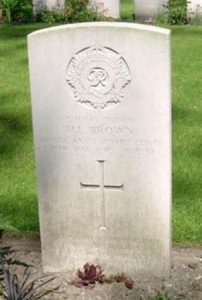
John Barbour Cowe, Gunner, 948953, Royal Artillery. John was born on 9 October 1918, the son of John and Isabella Govenlock Cowe, of Low Fell, Gateshead, Co. Durham. He enlisted into the Royal Artillery and was posted to the 3rd Survey Regiment, RA. The role of a Survey Regiment was to map and locate the position of enemy artillery, to enable accurate fire upon them. John’s unit must have been based locally to Llanidloes at the time that he died there on 16 June 1941. The 22-year-old is buried in Dolhafren Cemetery, Llanidloes. He is not commemorated on the Llanidloes war memorial as he was not a local man.
James William Edmunds, Able Seaman, D/JX 149848, Royal Navy. James was born on 14 Feb 1920, the son of Thomas William Edmunds and Maria Elizabeth Edmunds (nee Burnapp), of Llanidloes. His parents had met whilst Thomas was stationed at Bedford with the 7th RWF during the Great War. James enlisted into the Royal Navy prior to the war and was posted aboard HMS Glorious. She had originally been built as a Courageous-class battlecruiser during the First World War but during the late 1920’s was converted for use as an aircraft carrier. She re-commissioned in 1930 and spent most of the coming years operating in the Mediterranean. After the start of the Second World War in 1939, Glorious spent the rest of the year unsuccessfully hunting for the commerce-raiding German cruiser Admiral Graf Spee in the Indian Ocean before returning to the Mediterranean. She was recalled home in April 1940 to support operations in Norway following the German invasion. On 7 June 1940 Glorious left Norway after taking onboard a number of aircraft from RAF units operating there and set sail for the safety of Scapa Flow. On the following day, 8 June 1940, Glorious and her two escorting destroyers, Acasta and Ardent, was spotted by the German battleships Scharnhorst and Gneisenau, which opened fire upon the helpless ships, sinking all three with the loss of over 1,500 lives. James was 20-years-old when he was killed in the sinking of Glorious that day. He is commemorated on the Plymouth Naval Memorial, Devon.
Russel Chapman Hamer, MiD, Warrant Officer, 566261, Royal Air Force. Russel, known by his friends as Lofty, was born in 1916, the son of Richard Bryce Stephens Hamer and Edith Mary Hamer (nee Chapman), of Llanidloes. He joined the RAF as an Aircraft Apprentice at Halton in 1933 and qualified as an aircraft fitter. During 1938 he applied for pilot training and began his initial training at RAF Woodley in July, before moving to 7 FTS at Peterborough where he gained his wings. Following the outbreak of war, he was posted to 141 Squadron, RAF, which was reforming at RAF Turnhouse equipped with the obsolete Boulton Paul Defiant. Russel served with the Squadron throughout the Battle of Britain and in 1941 undertook a conversion course to fly the more modern Beaufighter. Russell saw plenty of action after his conversion course, shooting down several enemy aircraft from the squadrons base at RAF Ford, in West Sussex. On 9 September 1942 he took off from Ford flying Beaufighter V8265, together with his Navigator Edmund Walsh, on a routine patrol. The aircraft was then told of an enemy He111 some fifteen miles south-east of St. Albans Head, which Russell engaged and destroyed, but he had been hit by the German tail-gunner and one engine had been set ablaze. Russel managed to fly his aircraft back over the Isle of Wight where he ordered Edmund to bale out. Russell remained at the controls of the doomed Beaufighter, which crashed on the mainland at Boldre, north of Lymington, killing him instantly. He was Mentioned in Despatches for his gallantry. The remains of the 25-year-old were recovered from the wreckage and he was brought home for burial in Dolhafren Cemetery, Llanidloes.
Llewellyn Albert Jenkins, Baker, Merchant Navy. Llewellyn was born in Builth Wells in 1900, the son of Albert and Elizabeth Jenkins. He married Minnie Jones at Builth in 1924 and the couple set up home at 4, Picton Street, Llanidloes. Llewellyn was a Baker and upon enlisting into the Merchant Navy retained his profession, becoming ships baker aboard the SS Orama. Orama had been built for the Orient Line in 1924, but in 1940 was requisitioned by the Admiralty and converted to a troopship. The liner transported the BEF to Norway following the German invasion, but as Norway began to fall, she left Norway to return to Britain. On 8 June 1940 Orama was intercepted by the German battleships Scharnhorst and Gneisenau some 300 miles west of Narvik and was sunk with the loss of 19 lives. Some 200 survivors were taken prisoner by the Germans. Llewellyn was 39-years-old when he was killed that day and is commemorated on the Tower Hill Memorial, London.
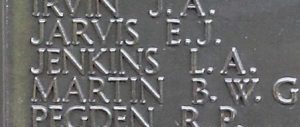
Gwilym Owen Jones, Private, 4188834, Queen’s Own Royal West Kent Regiment. Gwilym was the son of Margaret Jones, of Llanidloes. He married Hannah Amy Hayes, of Bersham, Denbighshire, in 1940. Gwilym enlisted into the army and was posted to the 4th Battalion, Queen’s Own Royal West Kent Regiment. The Battalion was a Territorial Army and was attached to the 132nd Infantry Brigade, 44th (Home Counties) Division. The Division was sent to France in April 1940 to join the BEF, and was stationed on the Franco-Belgian border. The Division then took part in the withdrawal to Dunkirk, before being evacuated to England. The Division then spent almost two years on home defence before embarking for North Africa in May 1942, and took part in the battles of Alam el Halfa and El Alamein. The Division was disbanded in early 1943 and the 4th Battalion was transferred to India, joining the 161st Indian Infantry Brigade, 5th Indian Infantry Division, near Kohima. On 8 April 1944 the Japanese launched a series of attacks against the outer defences of Kohima, beginning a brutal battle which would last for over ten weeks. The 4th Battalion was rushed forward to reinforce the troops fighting around the District Commissioner’s House, taking part in the ferocious fight known as the Battle of the Tennis Courts. Gwilym was killed in action here on 11 April 1944, just after an action in which a fellow member of his battalion gained the award of the Victoria Cross, for charging a Japanese machine-gun post, armed solely with his rifle and bayonet. The 30-year-old has no known grave and is commemorated on the Rangoon Memorial, Myanmar.
Gwilym Thomas Jones, Flight Sergeant, 370550, Royal Air Force. Gwilym was the son of William and Martha Jones, of Llanidloes. He lived in Birmingham prior to the war and married Florence Rawson there in 1936 before bring her back to Wales to live at 3, Short Bridge Street, Llanidloes. Gwilym enlisted into the Royal Air Force prior to the war and served with 802 Squadron, which was a Fleet Air Arm Squadron, based aboard the aircraft carrier HMS Glorious and equipped with the Gloster Sea Gladiator. She had originally been built as a Courageous-class battlecruiser during the First World War but during the late 1920’s was converted for use as an aircraft carrier. She re-commissioned in 1930 and spent most of the coming years operating in the Mediterranean. After the start of the Second World War in 1939, Glorious spent the rest of the year unsuccessfully hunting for the commerce-raiding German cruiser Admiral Graf Spee in the Indian Ocean before returning to the Mediterranean. She was recalled home in April 1940 to support operations in Norway following the German invasion. On 7 June 1940 Glorious left Norway after taking onboard a number of aircraft from RAF units operating there and set sail for the safety of Scapa Flow. On the following day, 8 June 1940, Glorious and her two escorting destroyers, Acasta and Ardent, was spotted by the German battleships Scharnhorst and Gneisenau, which opened fire upon the helpless ships, sinking all three with the loss of over 1,500 lives. Gwilym was 35-years-old when he was killed in the sinking of Glorious that day. He is commemorated on the Runnymede Memorial, Surrey.
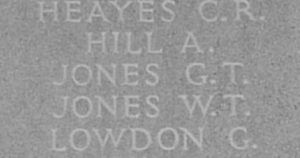
Hubert Kilwa Jones, Sergeant, 1186654, Royal Air Force Volunteer Reserve. Hubert was born in Llanelli in 1922, the son of Thomas Hubert Jones and Margaret Hannah Jones (nee Matthews). His father was from Llanidloes, and the family moved back there prior to the war. Hubert enlisted into the Royal Air Force Volunteer Reserve and trained as a Wireless Operator and Air Gunner before being posted to No 23 Operational Training Unit, to train aboard the Vickers Wellington medium bomber. On 3 January 1942, Hubert took off from RAF Pershore in poor weather conditions aboard Vickers Wellington T2953, which had been ordered to practice circuits and landings. During the exercise, whilst turning at very low altitude in in worsening visibility the Wellington crashed into a thickly wooded area, killing all five men aboard. Hubert was just 19-years-old when he was killed that day. His remains were brought home for burial in Dolhafren Cemetery, Llanidloes.
Luther Grantham Meek, Telegraphist, C/JX 149066, Royal Navy. Luther was born at Pontypridd on 15 November 1920, the son of Alfred Meek and Sarah Jane Meek (nee Brown). The family resided at Llanidloes prior to the war. Luther enlisted into the Royal Navy at some time prior to the war, and after training as a Telegraphist, was posted aboard the light-cruiser HMS Ajax. Following the declaration of war, Ajax was patrolling in the South Atlantic, off the River Plate, and had enjoyed some success in hunting German merchant ships before becoming the flagship of Force X, under the command of Admiral Henry Harwood, alongside HMS Exeter and HMS Achilles, and began hunting for the German pocket battleship, the Admiral Graf Spee. Ajax then took part in the famous Battle of the River Plate, where she sustained heavy damage, being hit seven times by the German heavy guns. Exeter was seriously damaged and had to leave the fray, limping to the Falklands for emergency repairs, leaving Ajax and Achilles to face Graf Spee alone, while waiting for a sister cruiser, HMS Cumberland, to join the fray. Following the unexpected scuttling of Graf Spee by her Captain, Hans Langsdorff, Ajax returned to Britain for refit, via Montevideo, Rio de Janeiro and Freetown, Sierra Leone, being joined en route by the aircraft carrier HMS Ark Royal, the battlecruiser HMS Renown and the destroyers Hasty, Hero, Dainty and Diamond, arriving at Plymouth at the end of January before being refitted and equipped with radar at Chatham Dockyards. Upon returning to service in August 1940, Ajax was allocated to the 7th Cruiser Squadron in the Mediterranean, and on 21 August left Britain, as part of a convoy escort group bound for Egypt. She then saw considerable service searching for Italian convoys over the coming weeks, whilst also covering some of the Malta convoys. On 12 October 1940 Ajax was on patrol alongside HMS Orion south-east of Malta, covering the return of Convoy MF4 to Alexandria, when the force came into contact with an Italian convoy in the Gulf of Otranto. Luther was killed during the engagement that day. The 19-year-old has no known grave and is commemorated on the Chatham Naval Memorial, Kent.
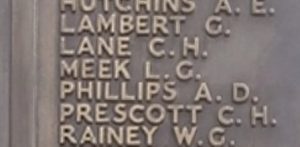
Alfred Mills, Fusilier, 4195145, Royal Welch Fusiliers. Alfred was born in 1920, the son of Mills Mills and Agnes Mills (nee Humphreys), of 28, High Street, Llanidloes. He enlisted into the 7th Battalion, Royal Welch Fusiliers, which was a Territorial Army battalion, attached to 158 Brigade, 53rd (Welsh) Division. The battalion was mobilised at the outbreak of war, when the Division moved to Northern Ireland to begin garrison duties. The Division then moved to Pembroke Dock, before moving again to the south of England, where it trained in readiness for the D-Day Landings. On 24 June 1944 the 7th RWF left England for Normandy, and landed at La Riviere near Ver Sur Mer. The Division then took part in heavy fighting over the coming weeks, as part of the effort to break-out of the Normandy beachhead. On 14 July, 158 Brigade was temporarily attached to the 15th (Scottish) Division, which had been ordered to launch an assault and seize the Farm de Mondeville, situated about 1,200 yards across a tributary of the River Orne on the South side of the road from Évrecy to Eterville. The 7th RWF moved into the assembly positions on the night of 15 July and launched their assault on the farm on the following morning. Alfred was killed in action during the initial assault on 16 July 1944. The 24-year-old was originally buried on the battlefield near Esquay, but on 2 January 1945 he was re-interred in La Delivrande War Cemetery, Douvres, France.
Thomas Hefin Morgan, Gunner, 959231, Royal Artillery. Thomas was the son of Edward Llewellyn Morgan and Sarah Jane Morgan, of 2, Cripplegate, Llanidloes. He worked as a sorting clerk and telegraphist for the Post Office prior to the war. Thomas enlisted into the Royal Artillery and was posted to 72 Field Regiment, RA where his skills as a telegraphist would have been very valuable. The regiment was a TA unit attached to the 50th (Northumbrian) Infantry Division and served in France with the BEF in 1940, seeing heavy fighting at Vimy Ridge and Arras before being evacuated from Dunkirk. Upon returning to England, the regiment assembled at Knutsford before moving to Weymouth and embarked for North Africa on 22 April 1941. The regiment saw service at Cyprus and Palestine over the coming months before moving to Libya and took part in the rout of the Afrika Korps before returning to Britain in the winter of 1942-43. Thomas must have served overseas with the regiment as he appears in casualty lists in 1942 and 1943. He died at Llanidloes on 28 May 1944. The 25-year-old was buried in Dolhafren Cemetery, Llanidloes.
John Clifford Owen, Seaman, LT/JX176582, Royal Naval Patrol Service. John was born on 29 August 1919, the son of William Owen and Mary Ann Owen (nee Davies), of 5, Castle Street, Llanidloes. He enlisted into the Royal Navy and was posted to the Royal Naval Patrol Service, before being posted aboard HM Trawler Strephon. She was a requisitioned trawler which had been converted by the Admiralty in 1940 for patrolling off the Scottish coast. On 20 November 1941 Strephon was moored in Aberdeen when John must have fallen overboard and drowned. His body was found in the Albert Basin, near No. 3 Jetty. The remains of the 22-year-old were buried in Newmachar Cemetery, Scotland.
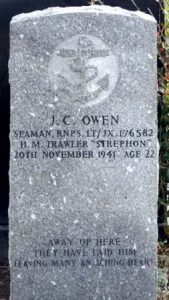
Norman George Edmund Perrett, Flight Sergeant, 1164775, Royal Air Force Volunteer Reserve. Norman was the son of Frederick James Perrett and Edith May Perrett (nee Cross), of 34, Long Bridge Street, Llanidloes. He enlisted into the Royal Air Force Volunteer Reserve and after completing his training was posted to 158 Squadron, RAF, which was based at RAF East Moor, equipped with the Handley Page Halifax heavy bomber. On 23 October 1942 Norman took off from East Moor aboard Handley Page Halifax II, Serial W7862, on a day/night raid on Genoa. Norman’s aircraft was lost over the English Channel on the outbound journey, with the loss of all eight of its crew. Norman was 22-years-old when he died that day and is commemorated on the Runnymede Memorial, Surrey.
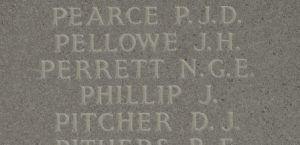
David Pugh, Corporal, 4181216, Royal Welch Fusiliers. David was the son of John and Mary Ann Pugh, of Llanidloes. He married Margaret Florence Williams in 1926, and the couple set up home at Llanidloes. David enlisted into the 7th Battalion, Royal Welsh Fusiliers, which was the local Territorial Army unit, attached to 158 Brigade, 53rd (Welsh) Division. The battalion was mobilised at the outbreak of war and 158 Brigade moved to Northern Ireland on 22 October 1939 to begin garrison duties, while the remainder of the Division moved to Pembrokeshire. The 7th RWF moved to Londonderry, to garrison the important harbour. The main enemy at the time was the IRA, which was active in Northern Ireland, and had been carrying out several raids on barracks and ambushes on army patrols. The other two brigades of the 53rd Division moved to Northern Ireland some weeks later, to join 158 Brigade. David died in Ireland on 22 February 1940. The body of the 36-year-old was brought home for burial in Dolhafren Cemetery, Llanidloes.
Thomas Stephen Pugh, Civilian. Thomas was the son of Richard and Sarah Pugh, of 7 Westgate Street, Llanidloes. By 1911 he was working as a Printer’s Compositor and was lodging at 1, Plasnewydd Street, Maesteg. Thomas married Annie Margretta Grey Davies at Maesteg two years later. He doesn’t appear to have served during the Great War and by 1938 the couple were residing at 183 Wellington Hill West, Henleaze, Bristol, where Thomas worked for the Bristol Aeroplane Works, at Filton. The Works, at Filton and Patchway, was the largest aircraft production facility in the world and thus of great importance following the invasion of Europe by Nazi Germany. The factories at Filton and Patchway remained unscathed throughout the first months of the war, but from August 1940 the area became targeted by the Luftwaffe. On 25 September 1940 the largest attack of the War on the Filton works occurred, with some 58 bombers escorted by 50 Messerschmitt long-range fighters being despatched to attack the Works. Despite being heavily protected by anti-aircraft guns, and around 11.50 that day the first bombs struck the factory, and some 168 bombs hit the site, destroying a number of newly completed aircraft, but the worst damage was the loss of 131 lives due to several air raid bunkers being hit. Thomas was among those killed during the raid. The 58-year-old is probably buried with most of the other casualties of the raid in Greenbank Cemetery. Thomas is not commemorated on the Llanidloes war memorial.
James Norman Rees, Fusilier, 4188393, Royal Welch Fusiliers. James was born in London in 1913, the son of James Charles Rees and Mary Ann Rees (nee Ward). His father was from Llanidloes, and after returning from fighting in the Great War, moved his family back to Llanidloes. James married Emily Anne Davies, of Bethesda, Caernarvonshire in 1936. James enlisted into the 7th Battalion, Royal Welch Fusiliers, the local TA unit which was attached to 158 Brigade, 53rd (Welsh) Division. The battalion was mobilised at the outbreak of war, when the Division moved to Northern Ireland to begin garrison duties. The Division then moved to Pembroke Dock, before moving again to the south of England, where it trained in readiness for the D-Day Landings. On 24 June 1944 the 7th RWF left England for Normandy, and landed at La Riviere near Ver Sur Mer. The Division then took part in heavy fighting over the coming weeks, as part of the effort to break-out of the Normandy beach-head, seeing heavy fighting at Évrecy. James was killed during a patrol which crossed into enemy territory to reconnoitre Farm de Monraville on 20 July 1944. The 31-year-old is buried in Banneville-La-Campagne War Cemetery, France.
Walter Slawson, Ordinary Seaman, P/SSX 26105, Royal Navy. Walter was born at Llanidloes on 11 September 1919, the son of Thomas Slawson and Harriet Howell Slawson (nee Owen). He had enlisted into the Royal Navy prior to the war and served aboard the famous battleship, HMS Royal Oak. The ship had taken part in the Battle of Jutland in 1916 but had been modernised in the inter-war period. Despite the work carried out, she was deemed as too slow for modern Naval warfare, so was placed on the Home Fleet at Scapa Flow. On 14 October 1939 Royal Oak was anchored safely in Scapa Flow, with most of her crew asleep in their bunks, all blissfully unaware that the German submarine U-47, commanded by Gunther Prien, had negotiated her way into the waters. Suddenly at 01.04 a torpedo, fired from the German submarine struck the bow of Royal Oak, shaking the mighty ship and waking the crew. The crew initially thought there had been an internal explosion, but twelve minutes later a salvo of three torpedoes were fired at the helpless ship, which ignited the ships batteries and caused a massive explosion which sank her. 835 men were lost as a result of the loss of the Royal Oak. The ship still lies upside down in Scapa Flow today, a designated war grave. Walter was 23-years-old when he was lost aboard her and is commemorated on the Portsmouth Naval Memorial, Hampshire.
